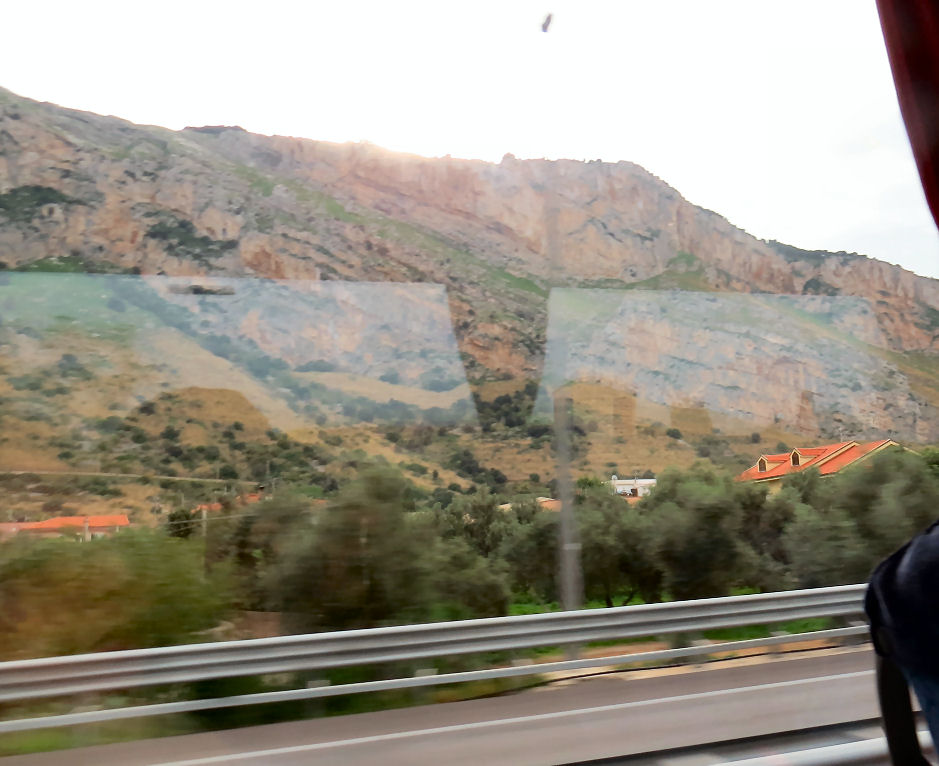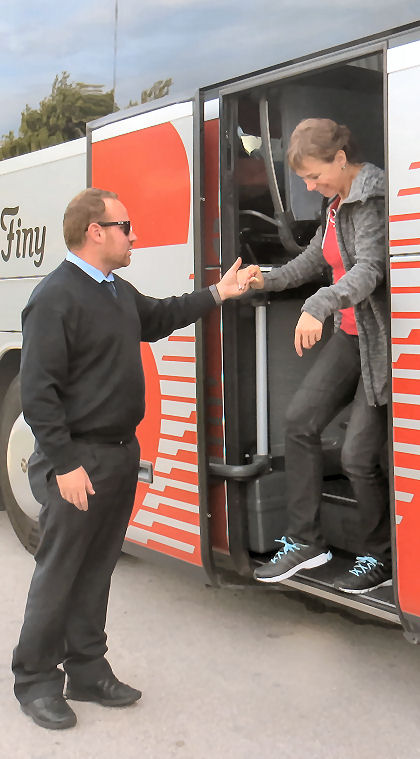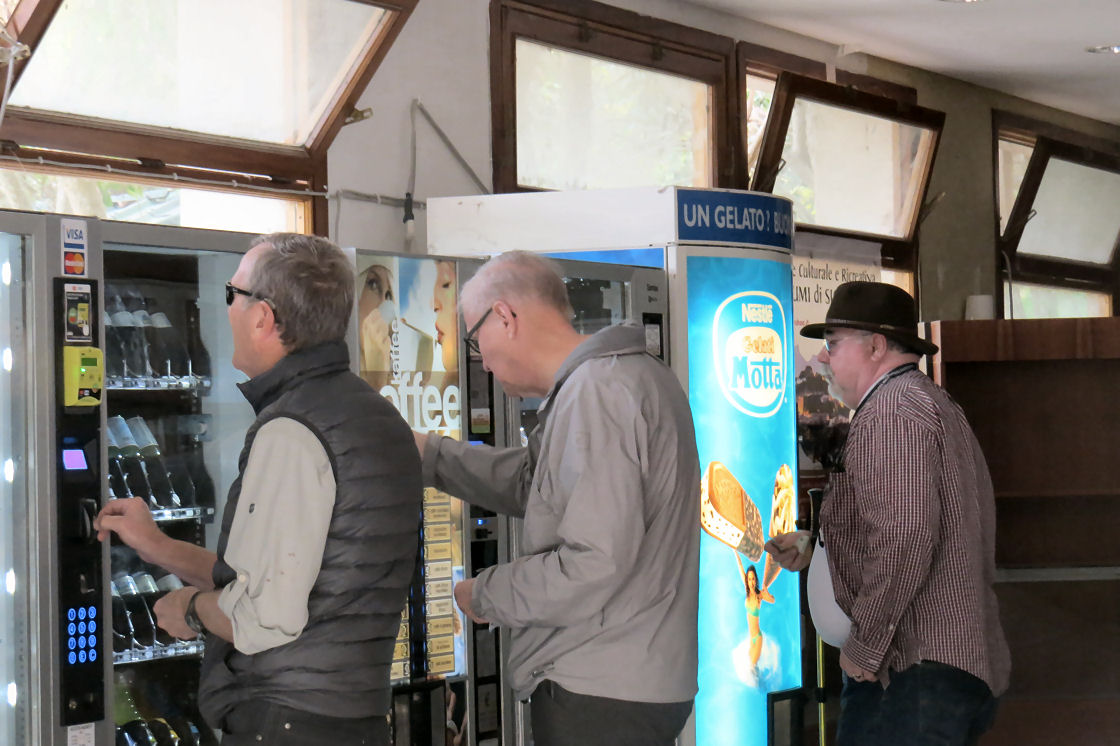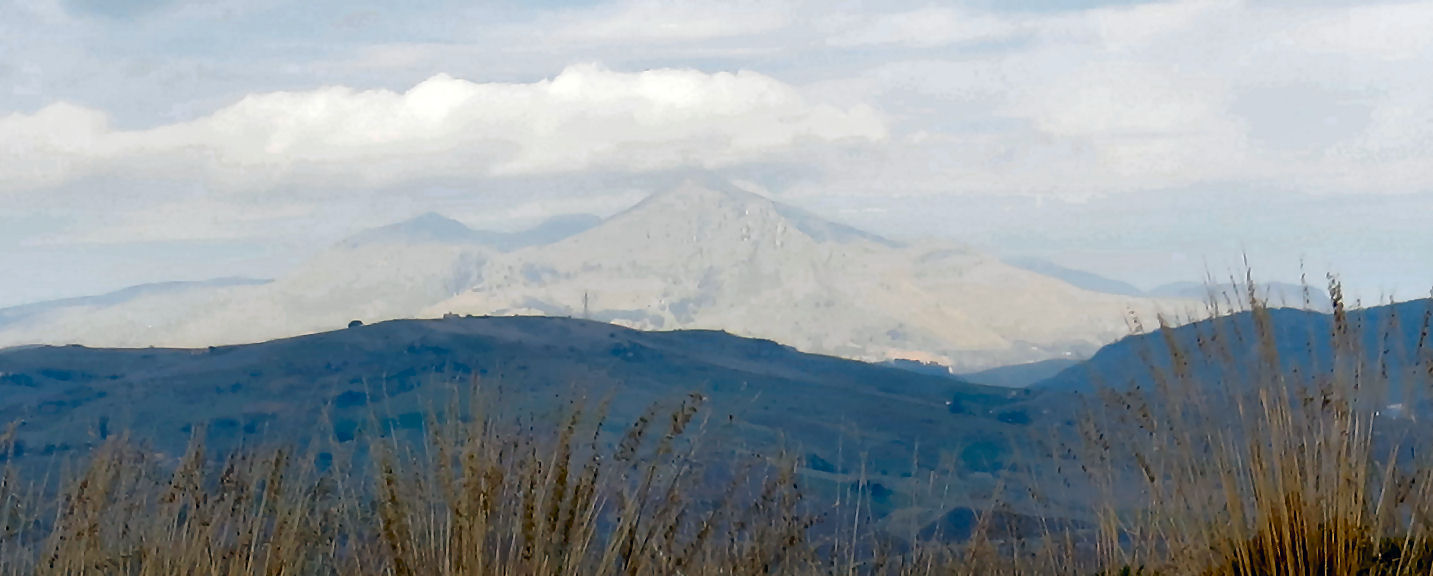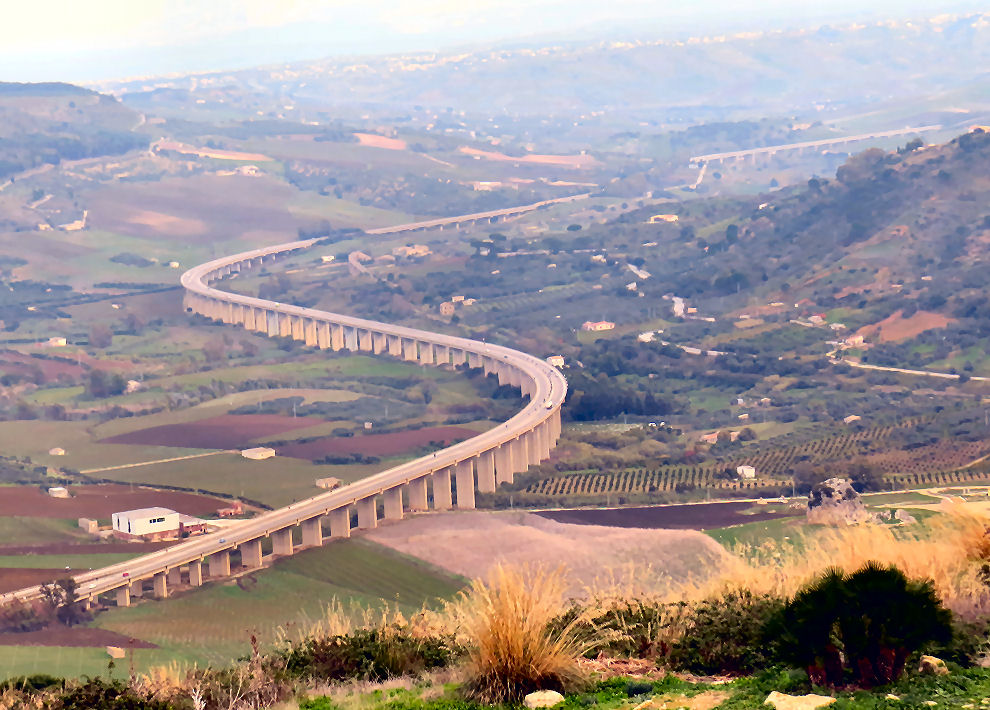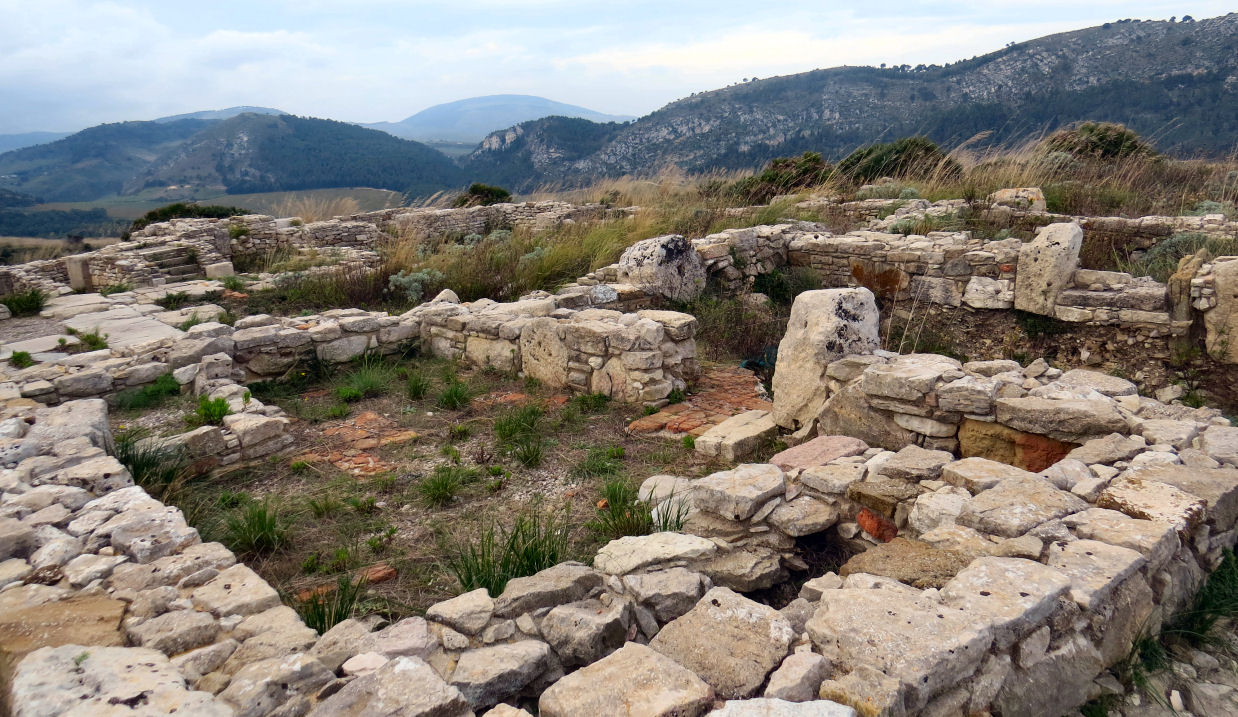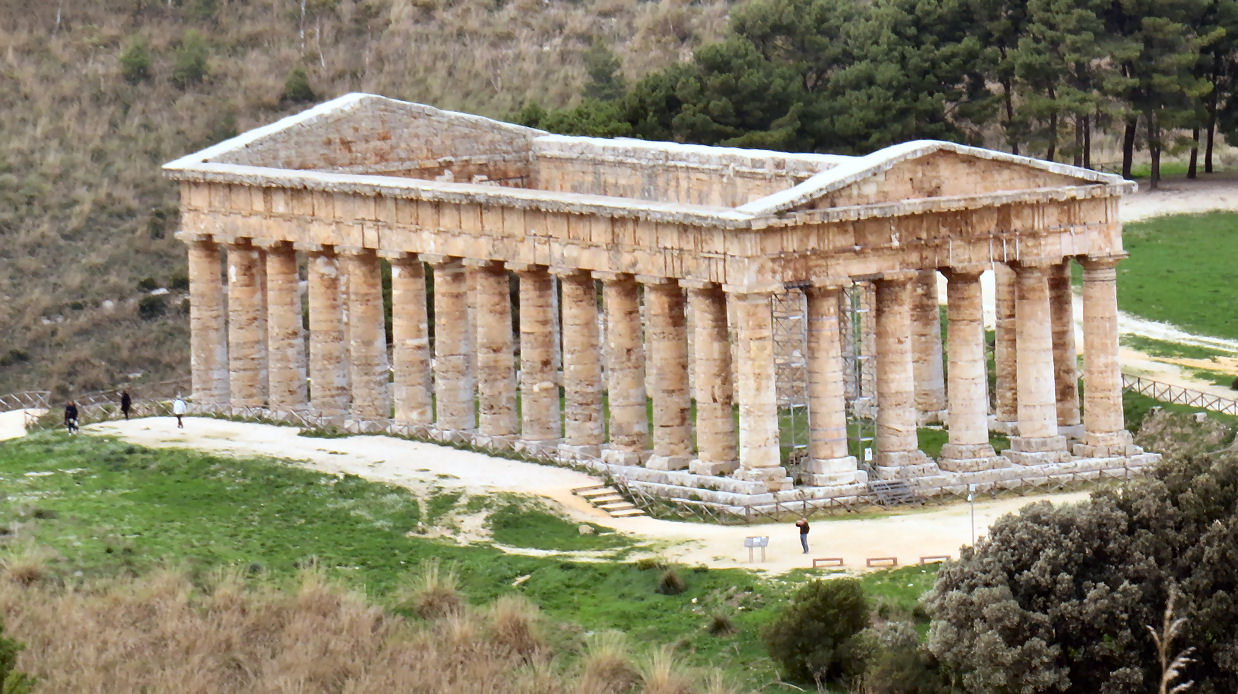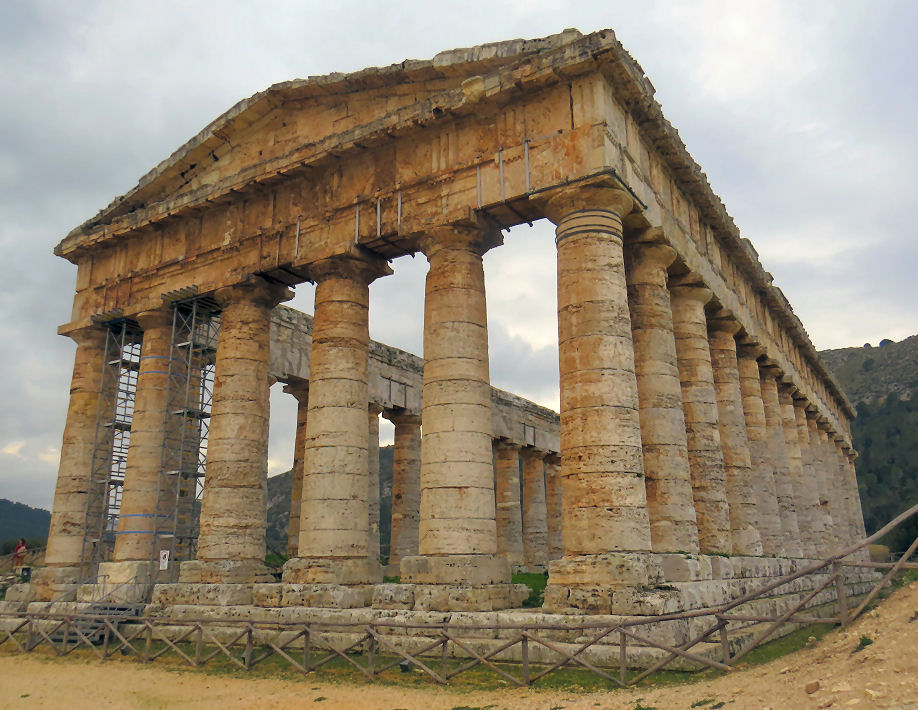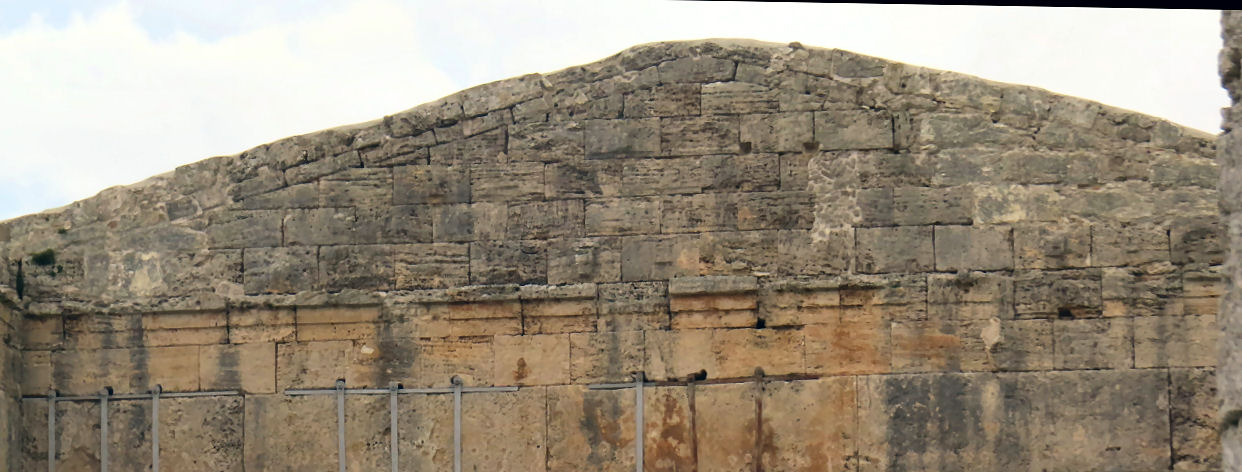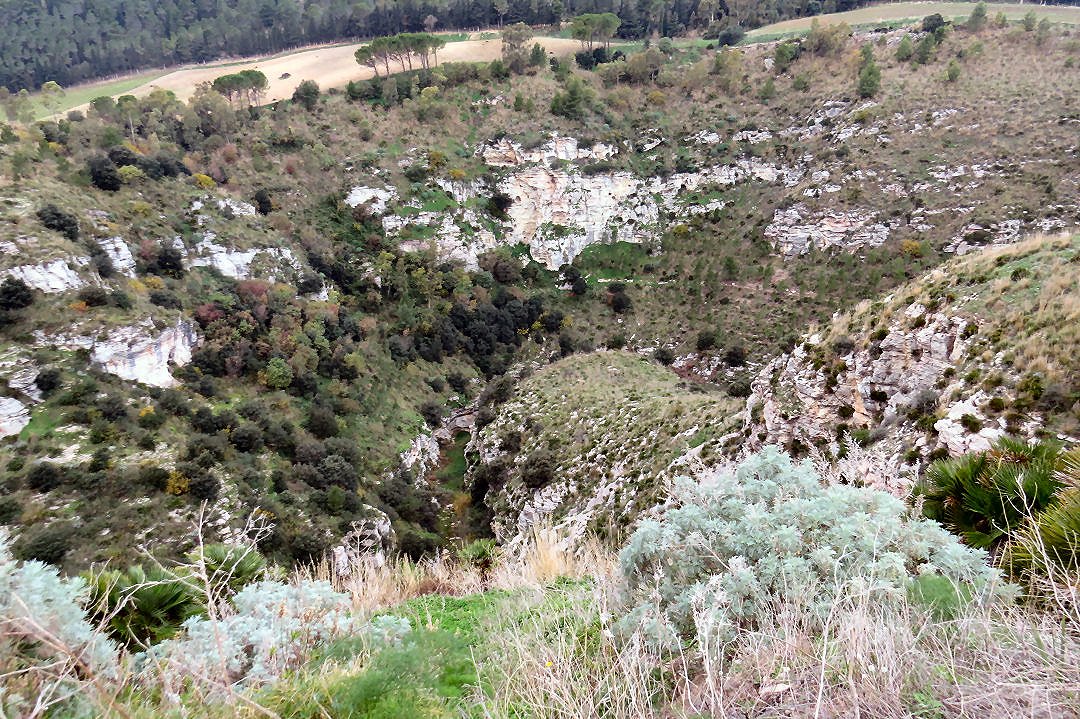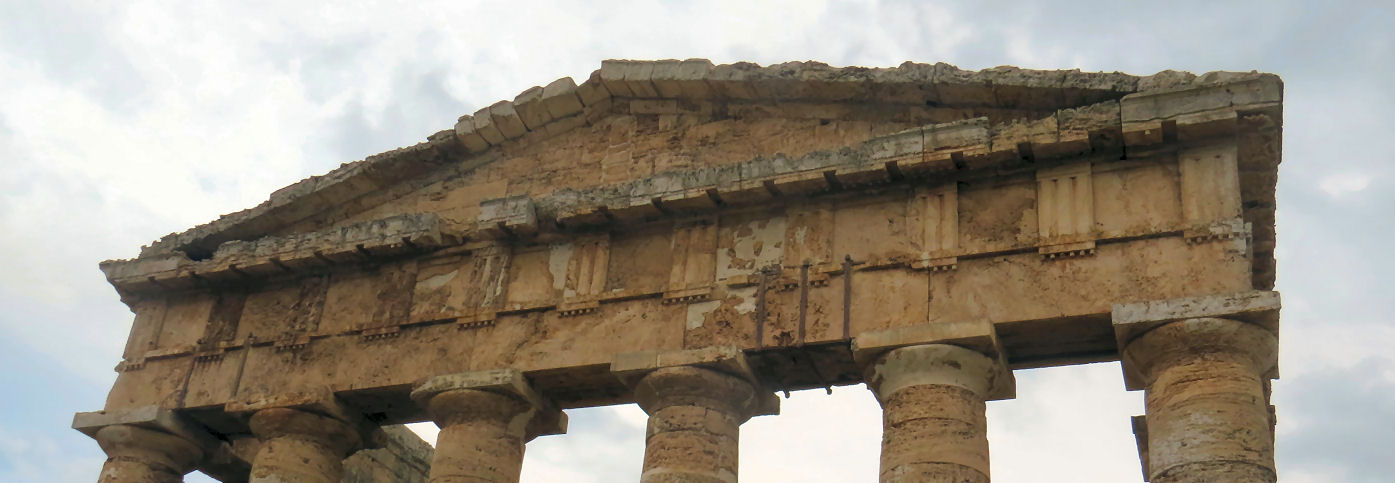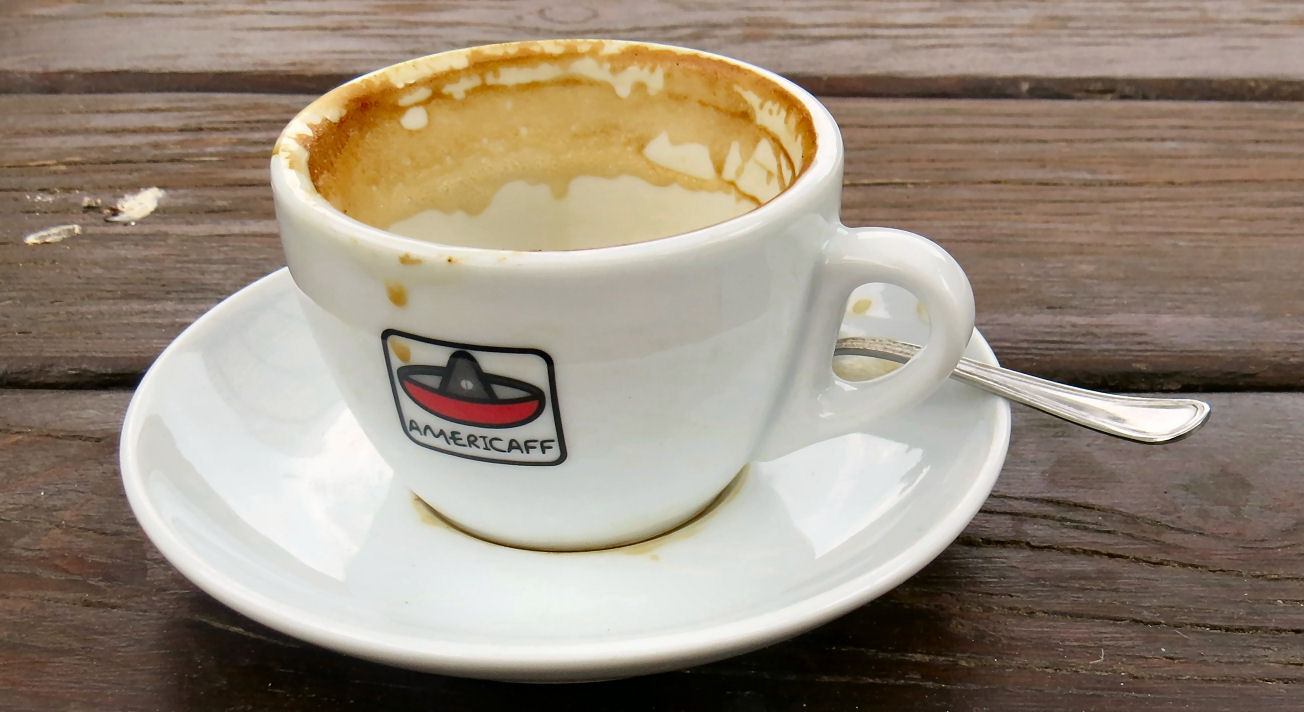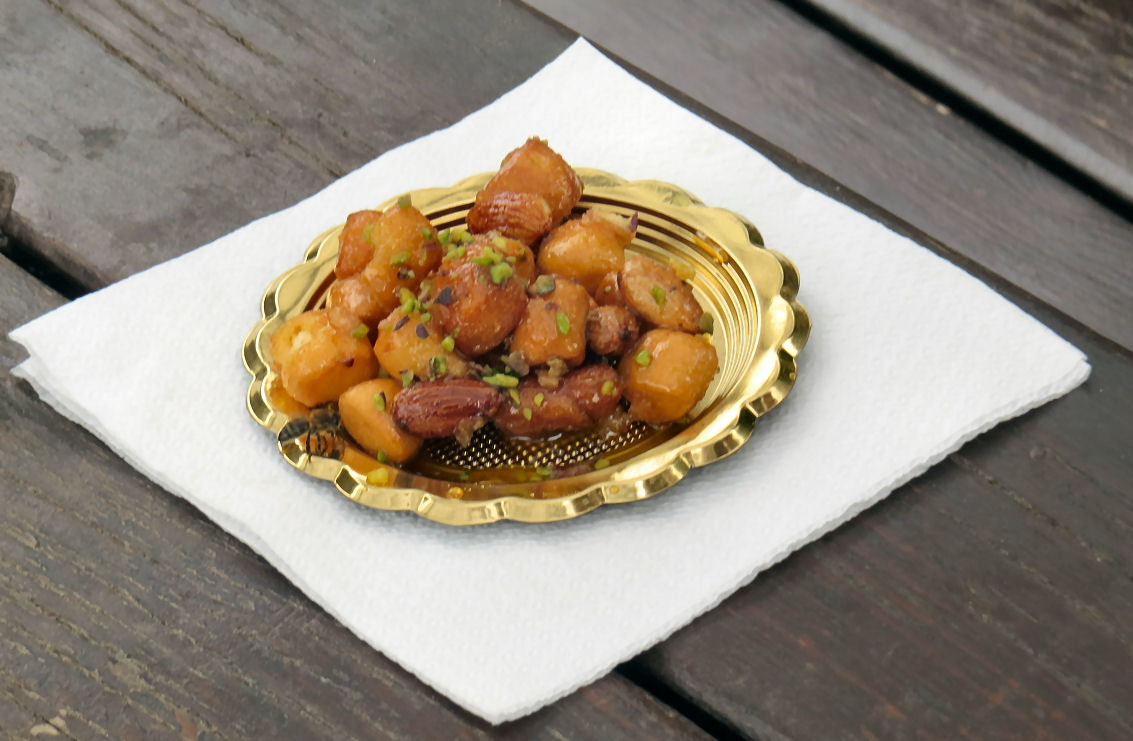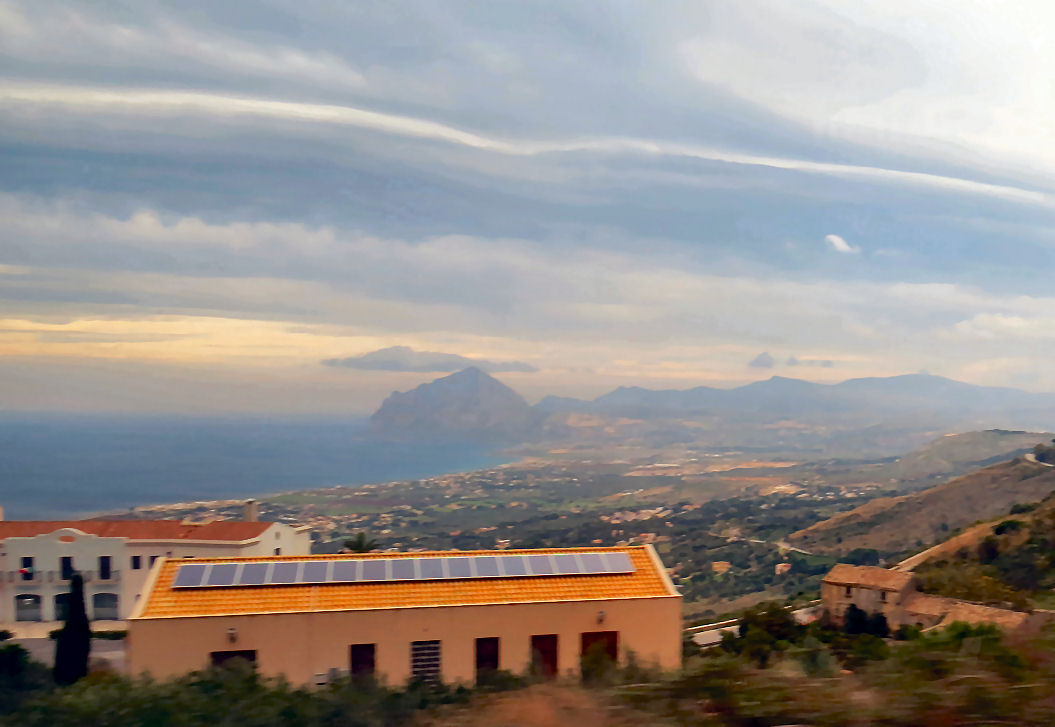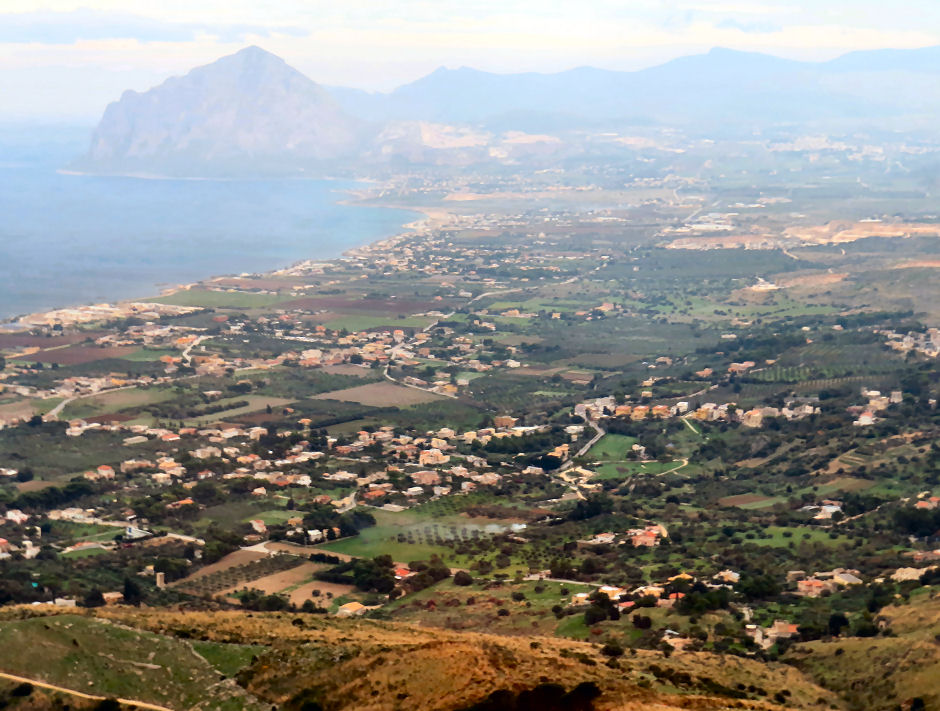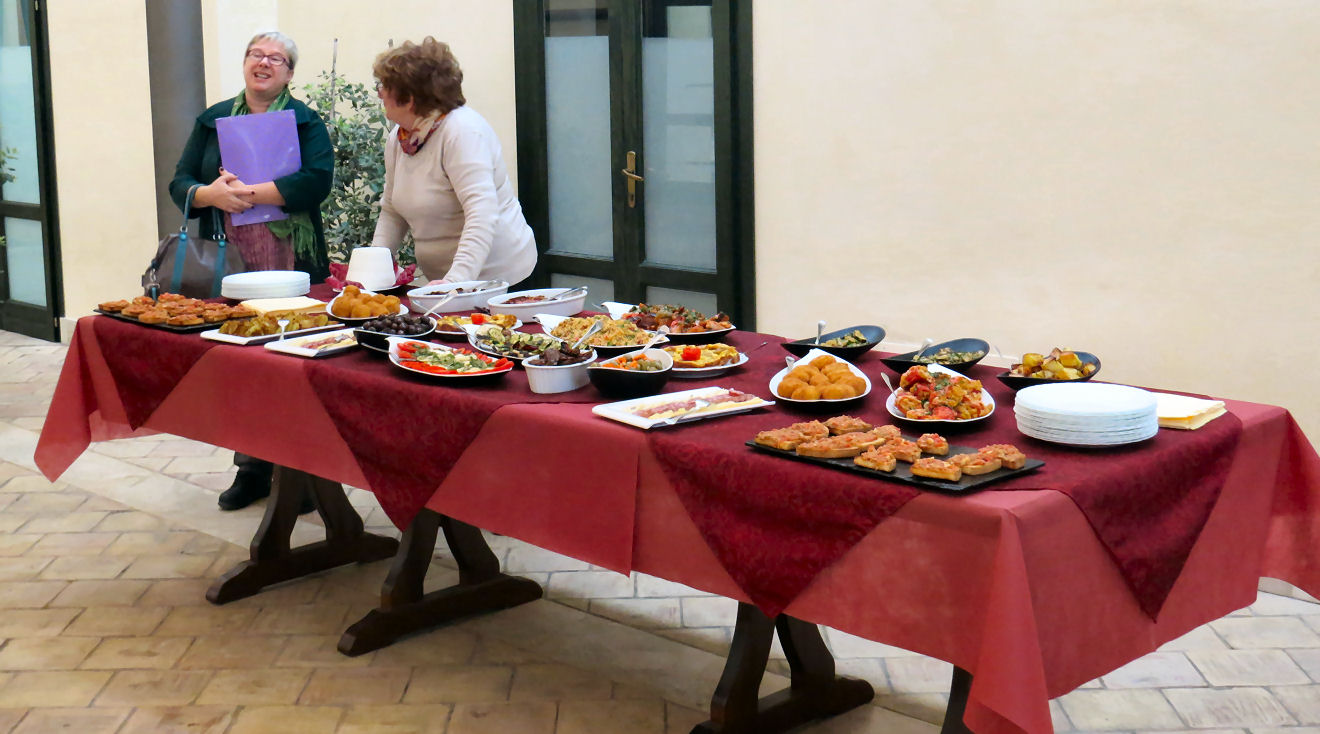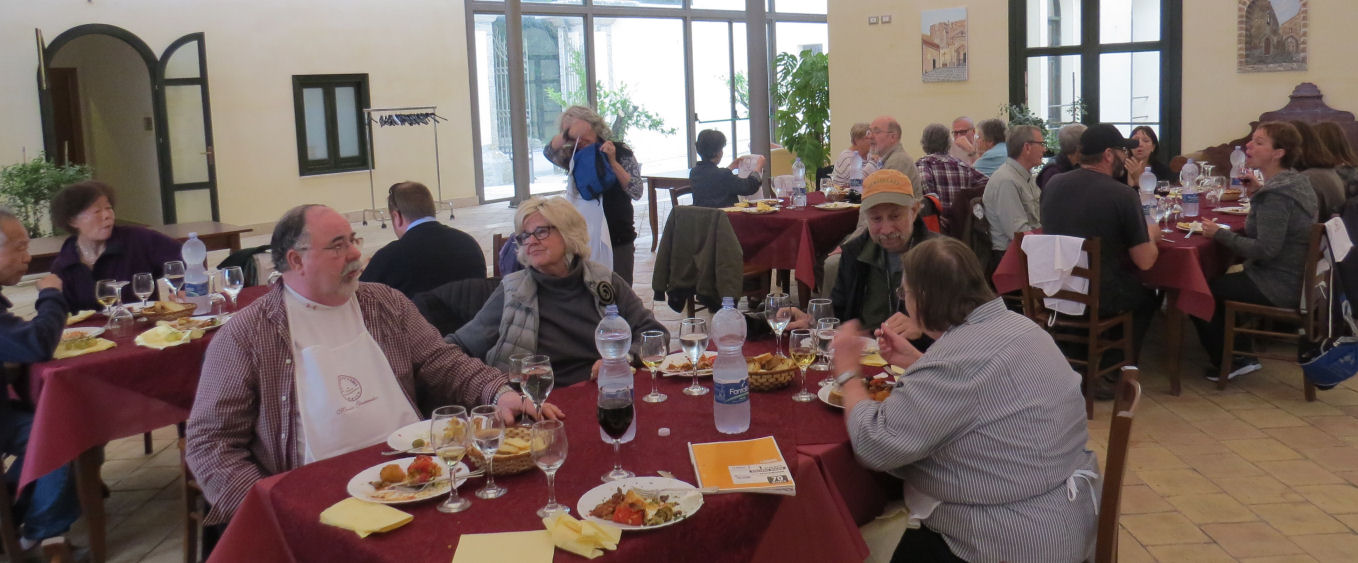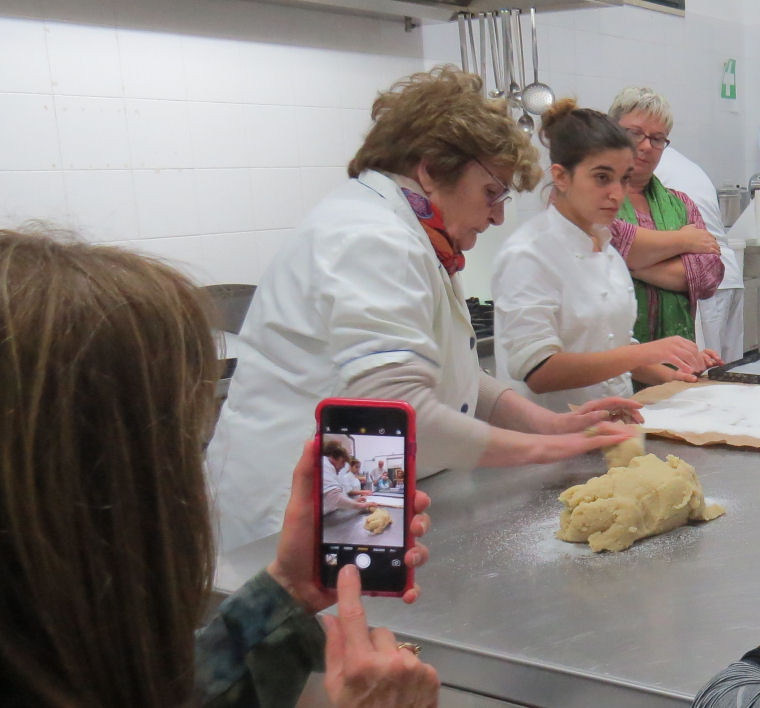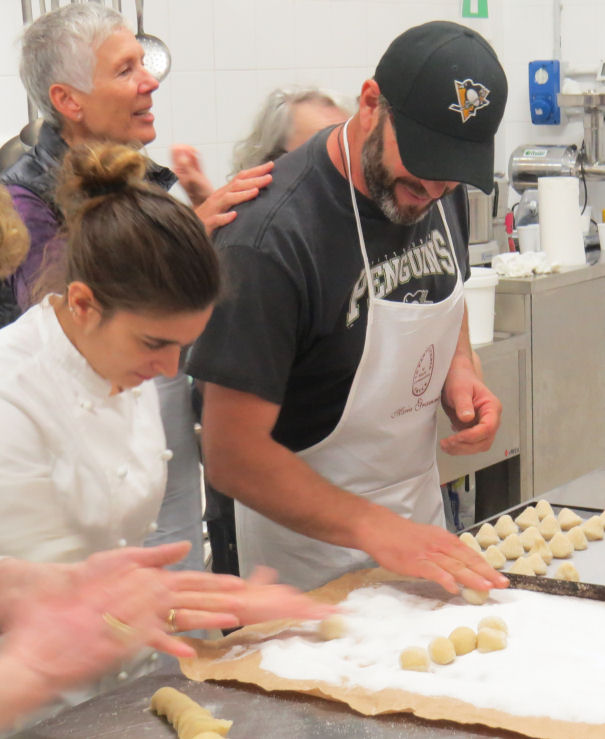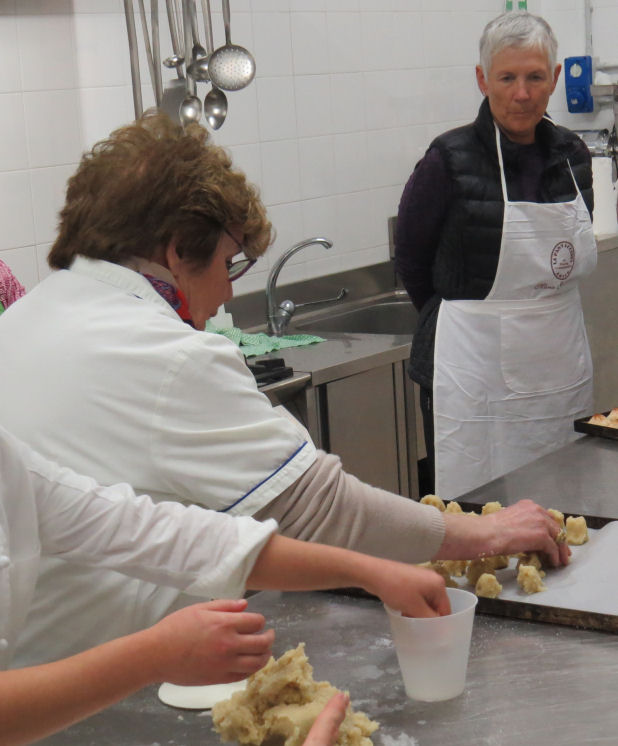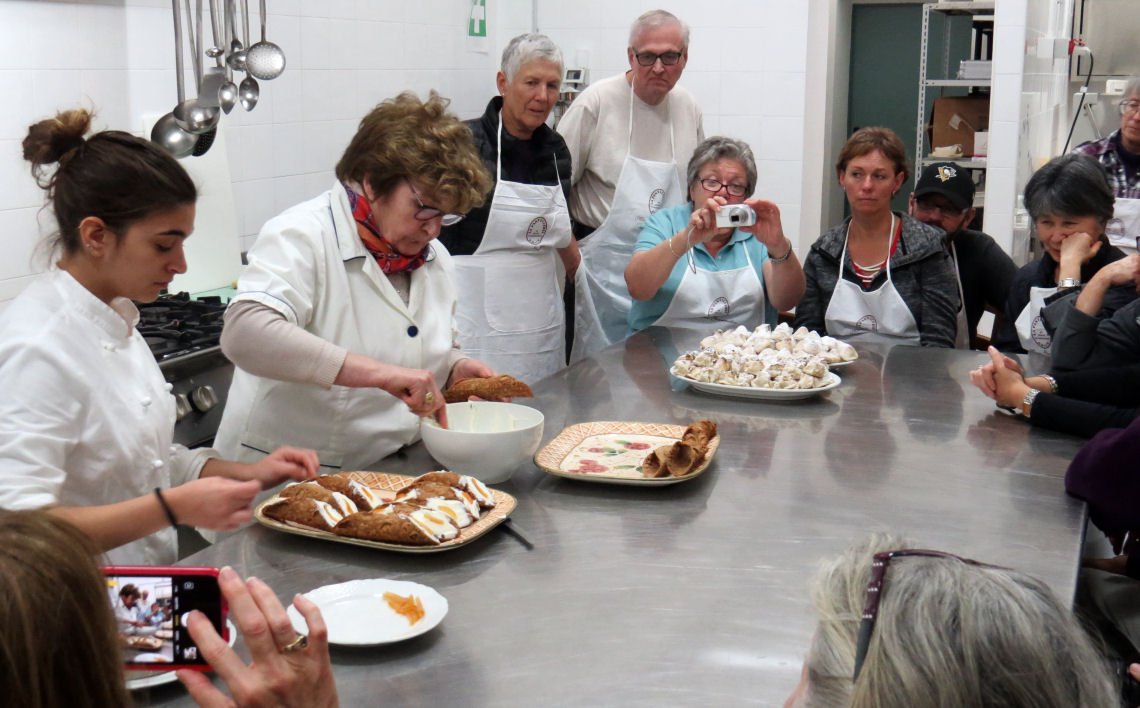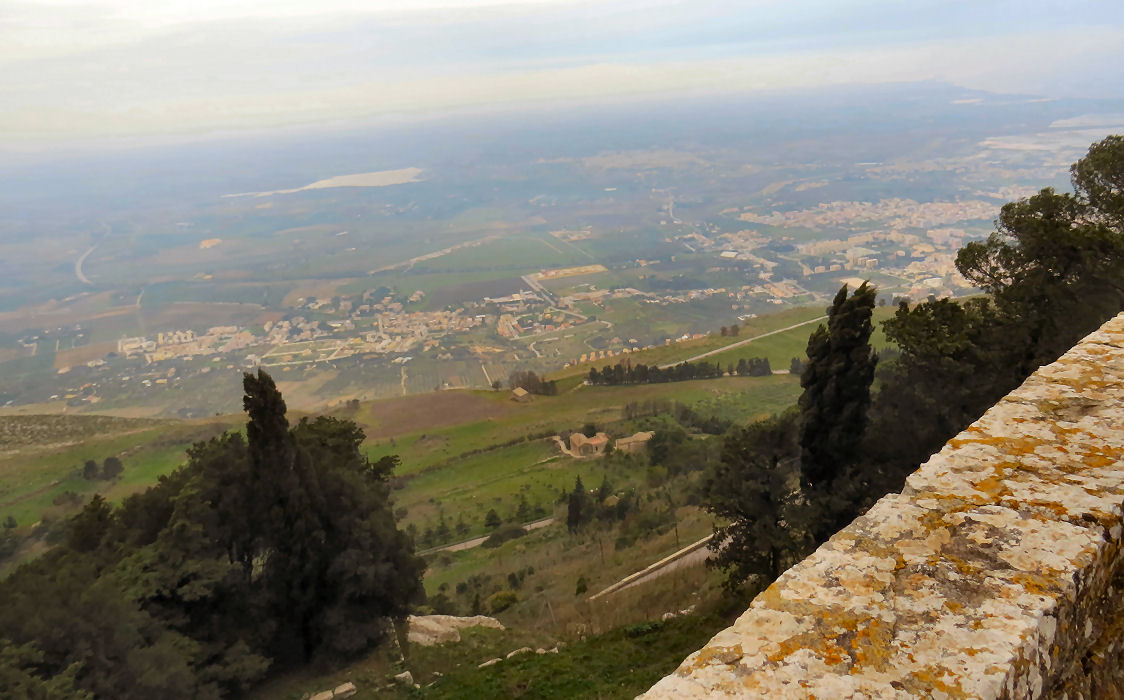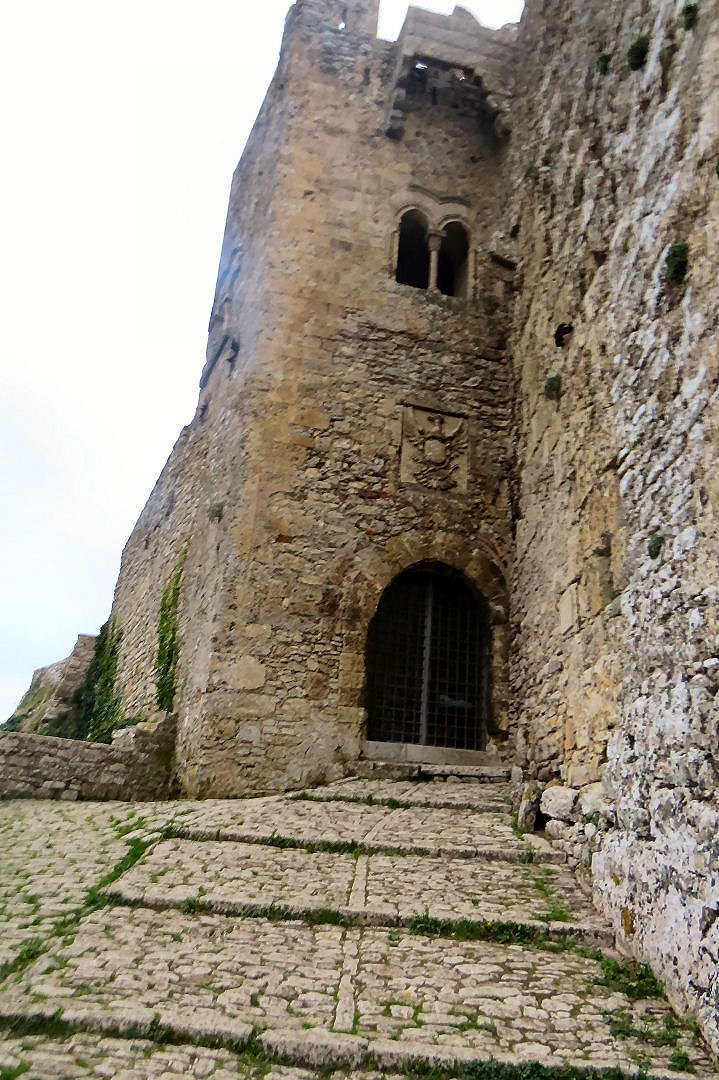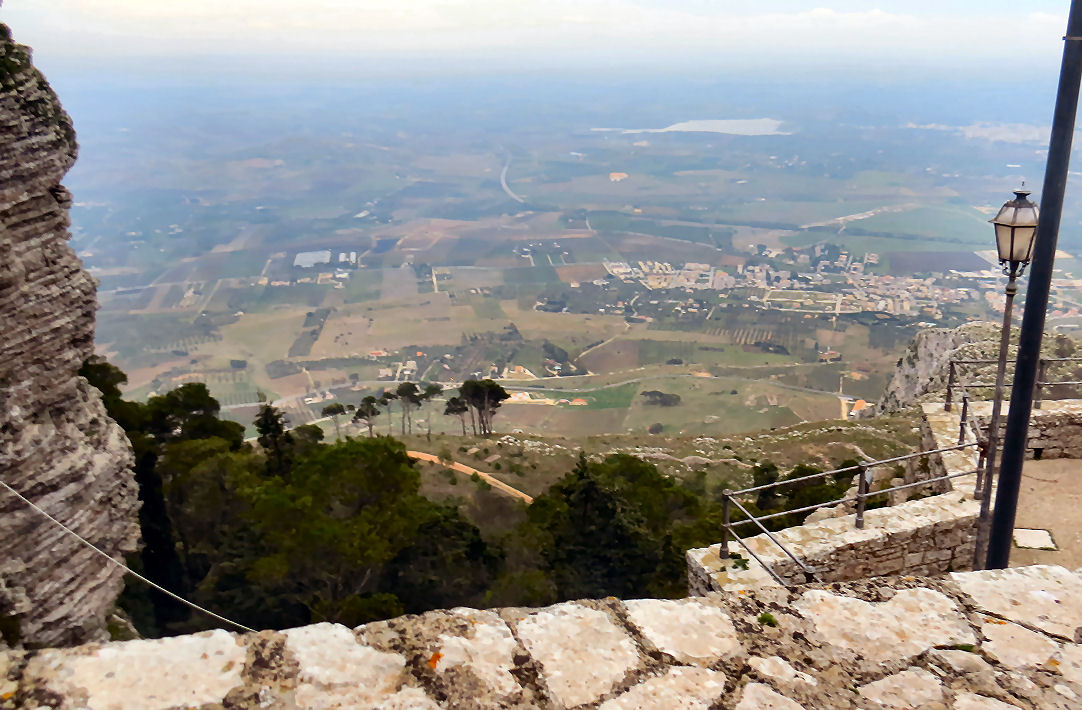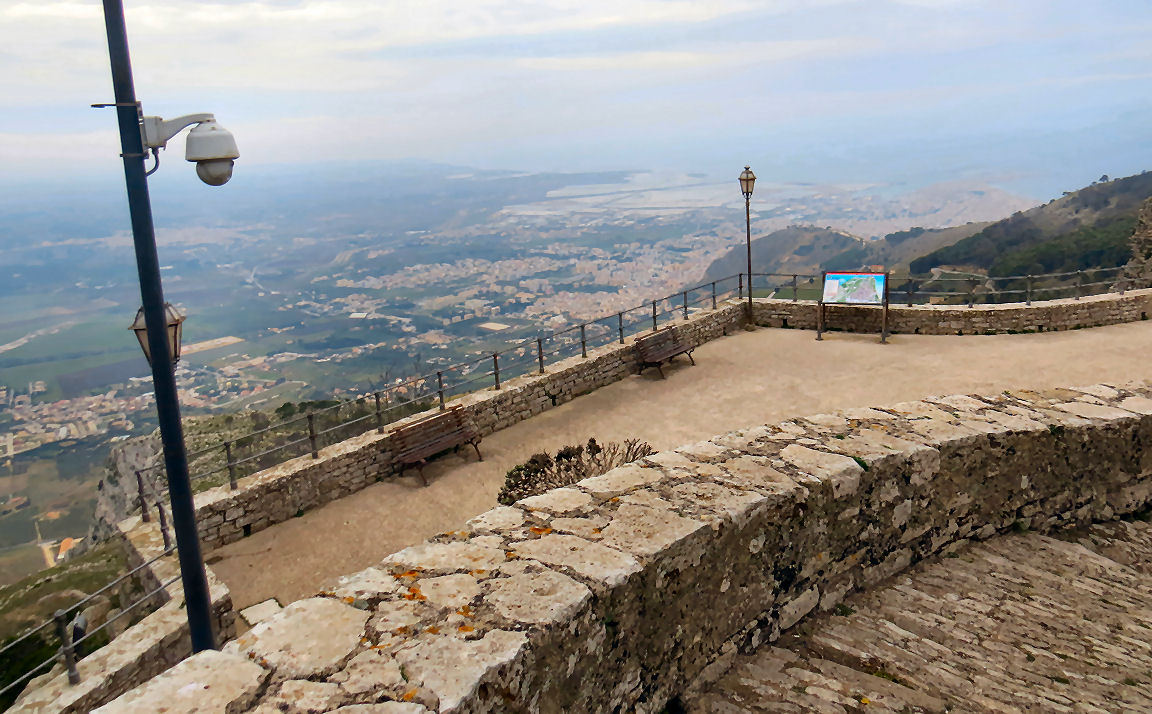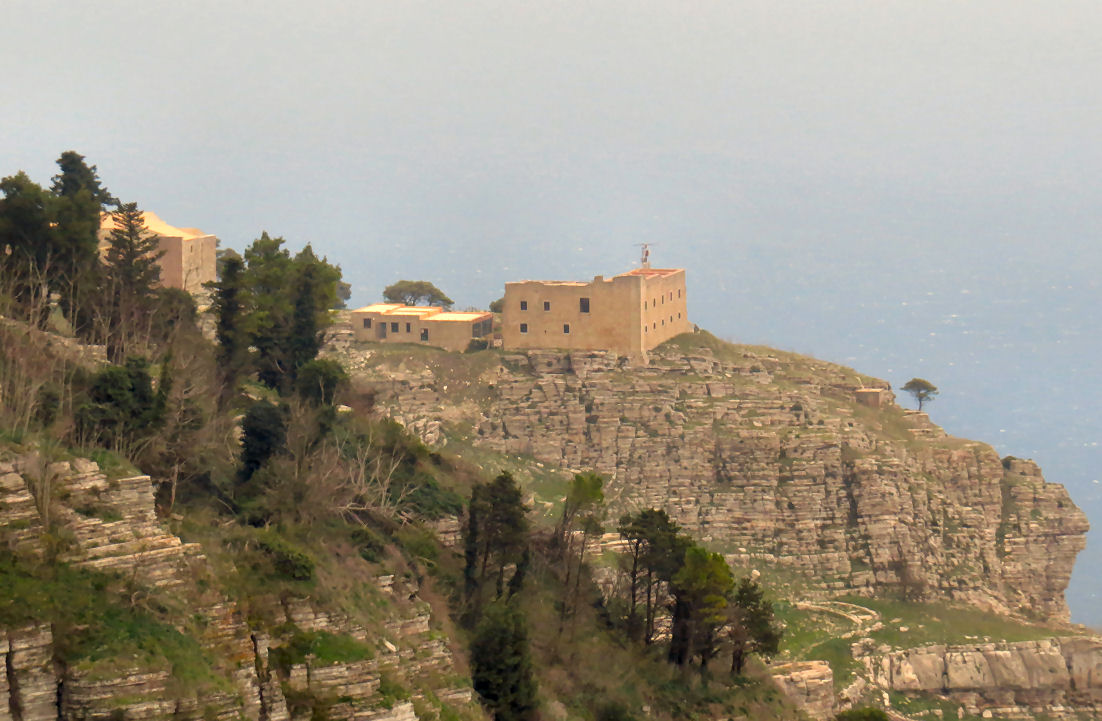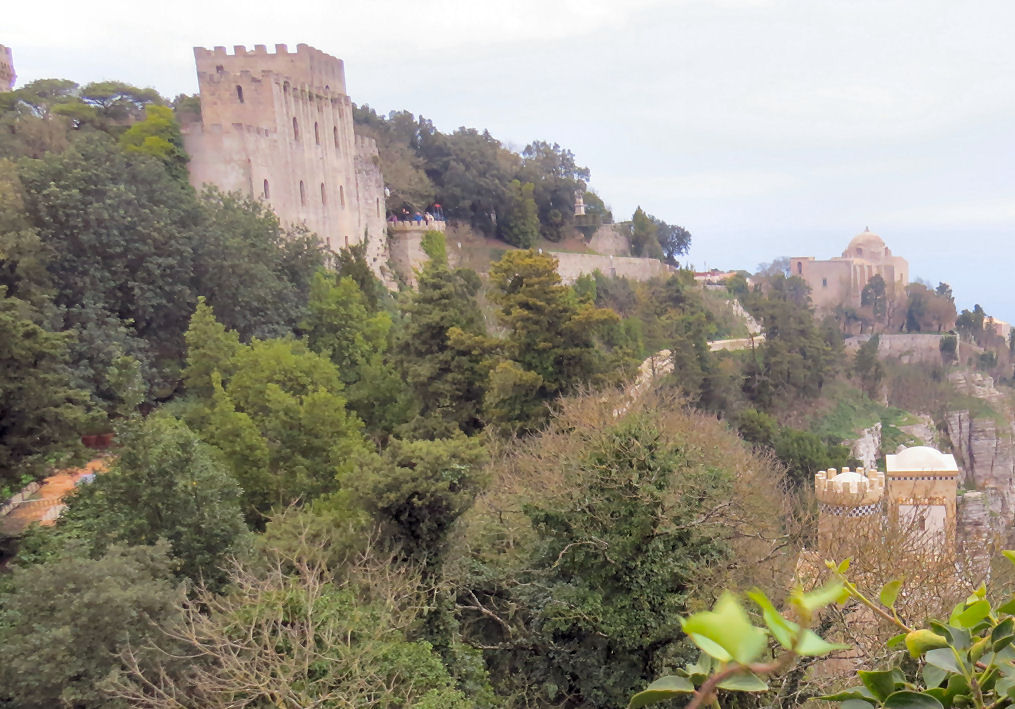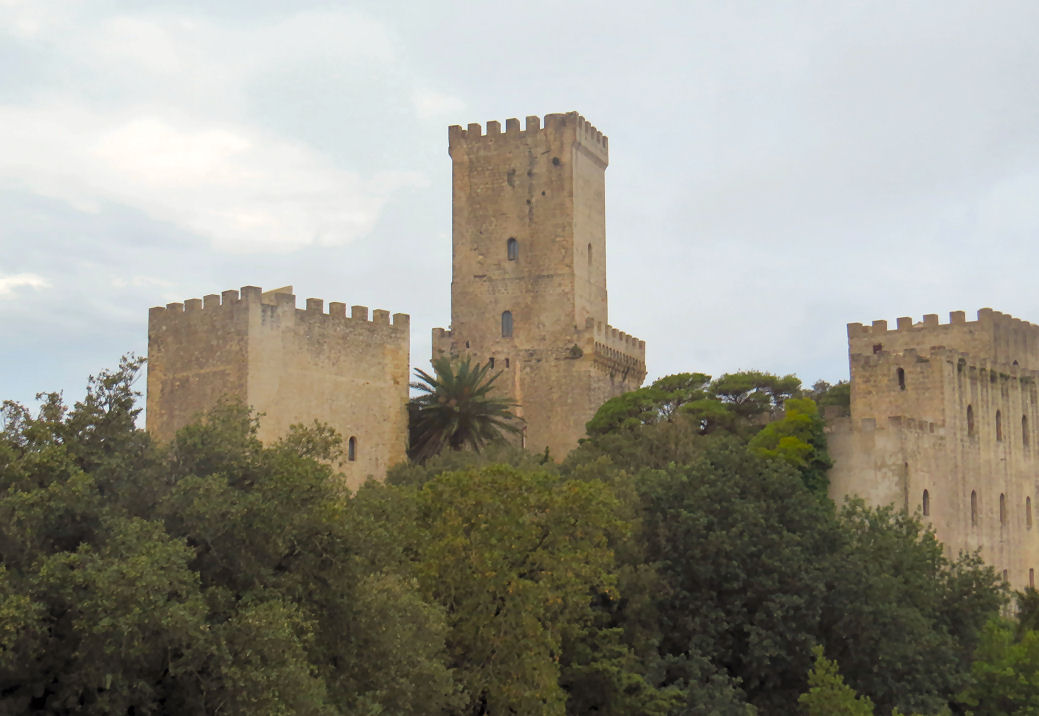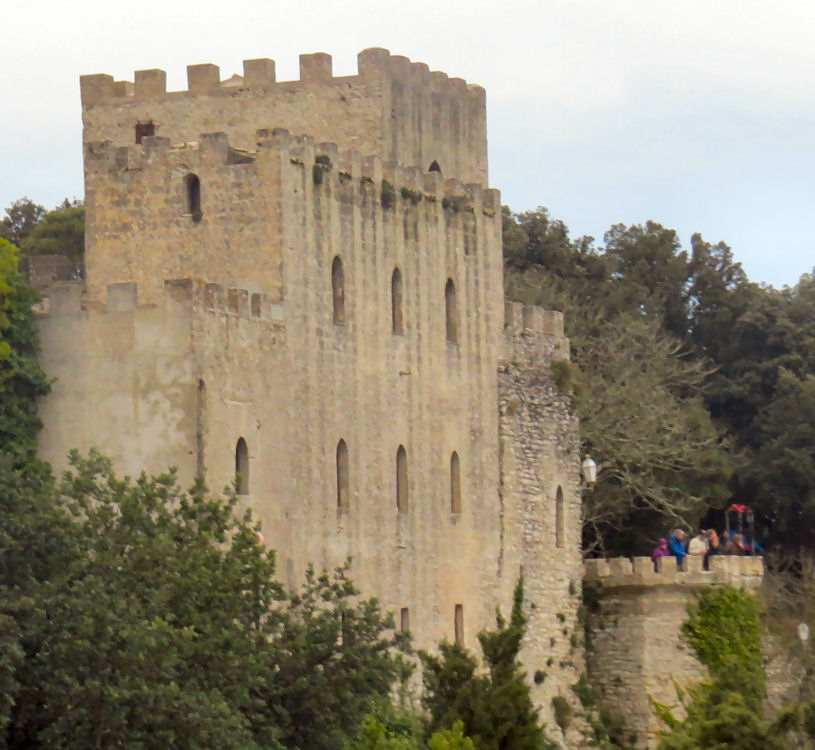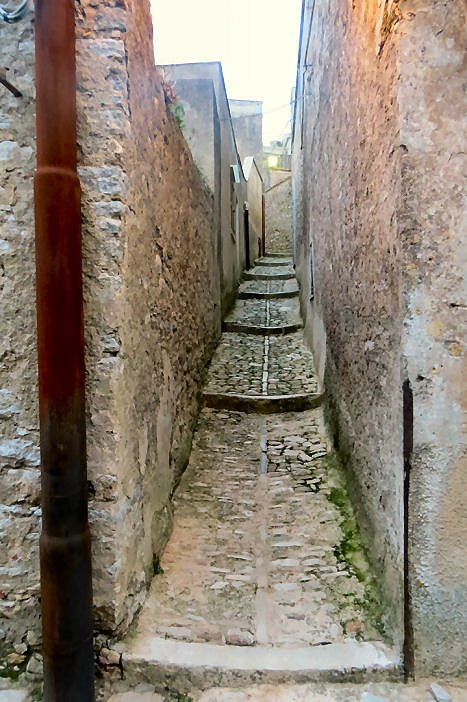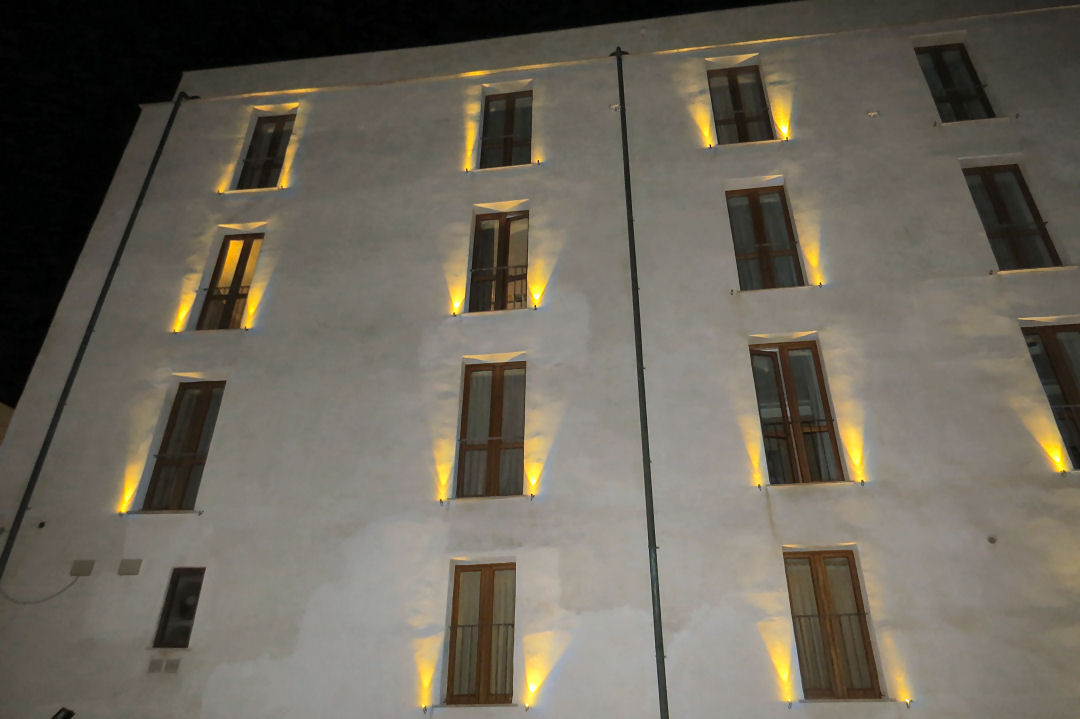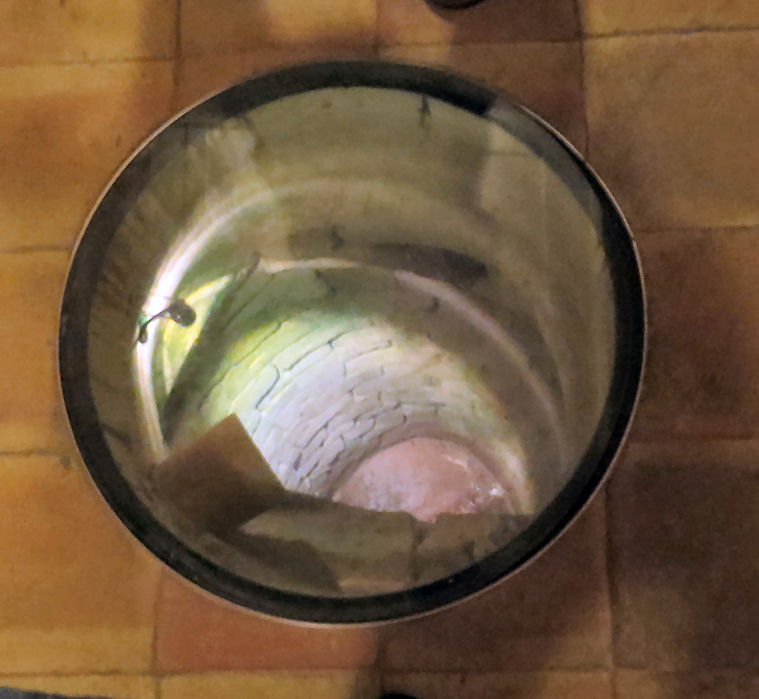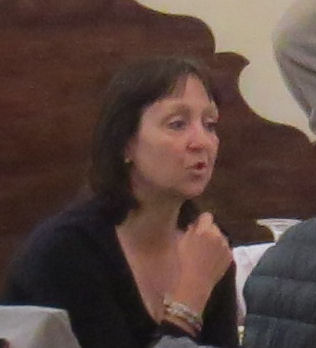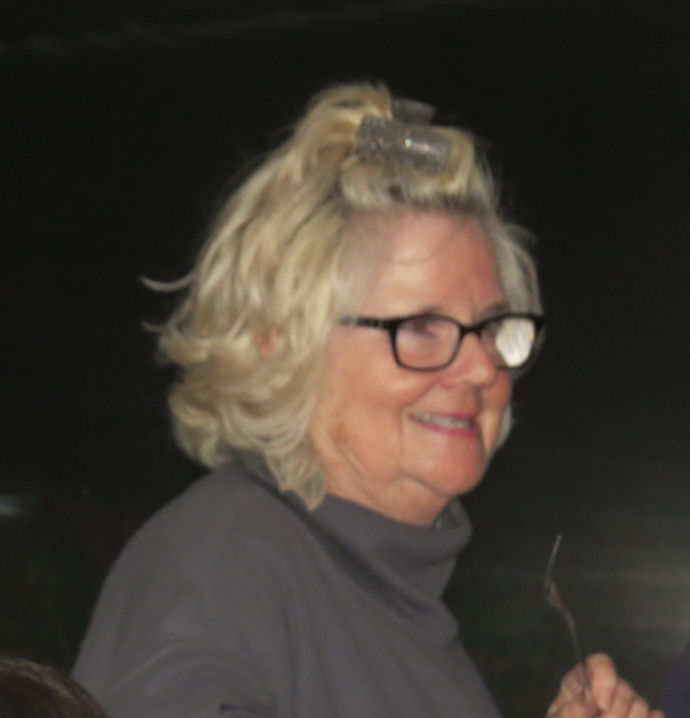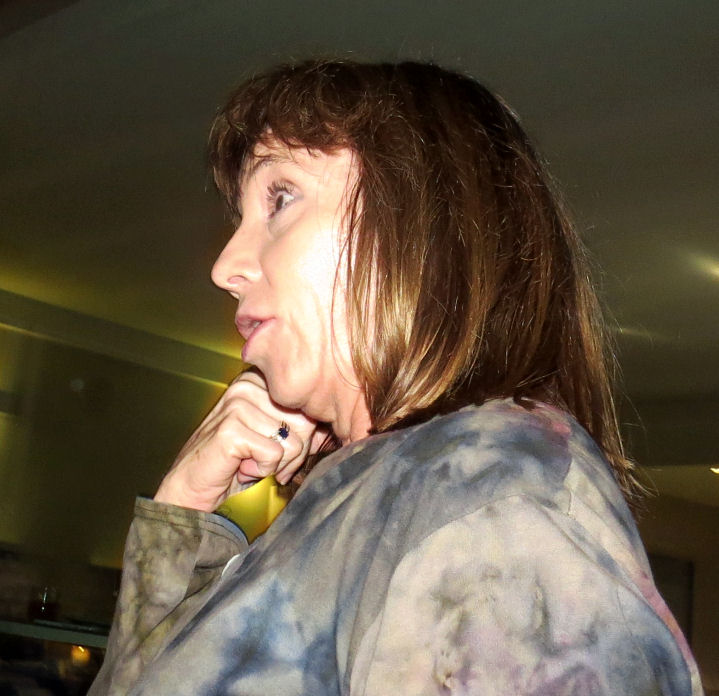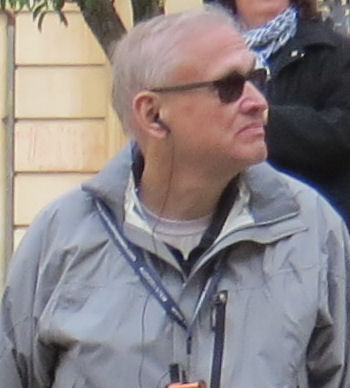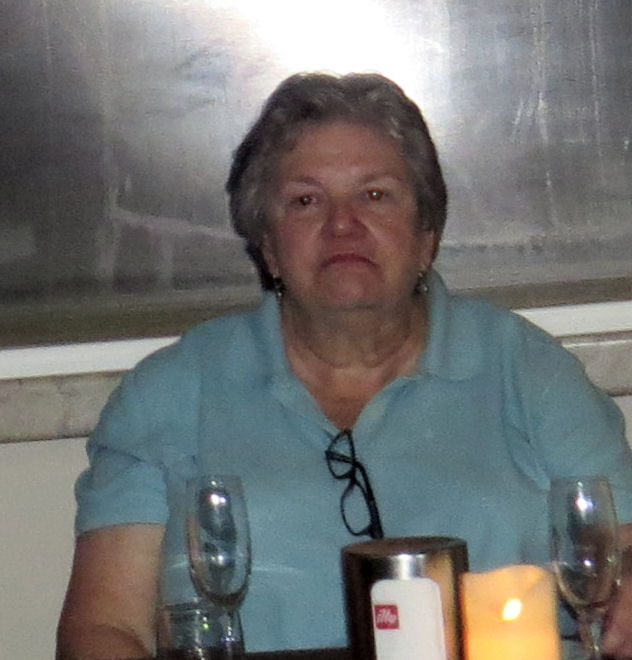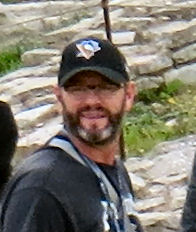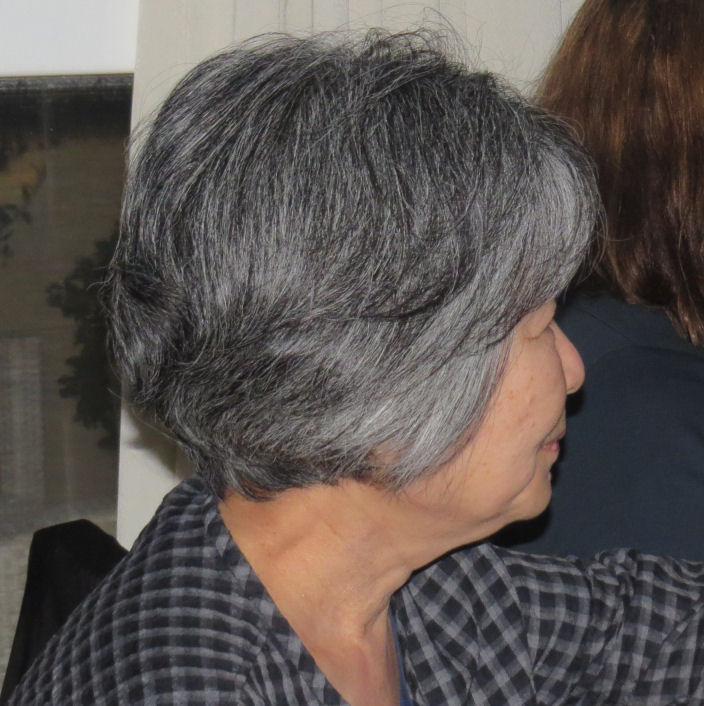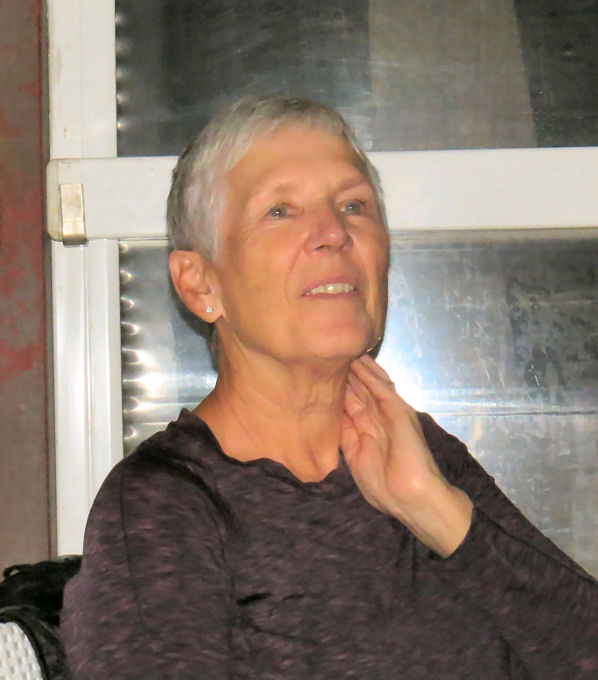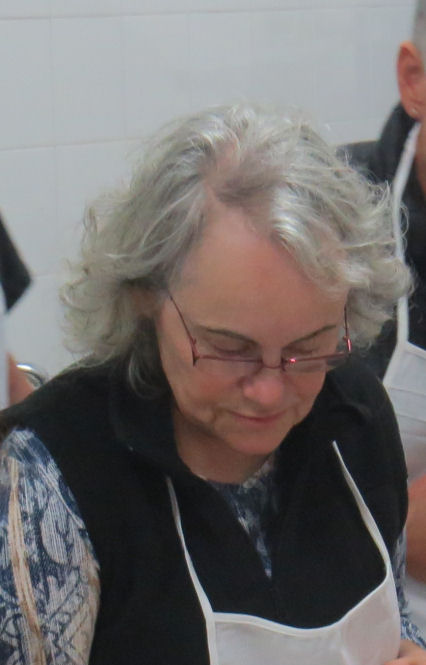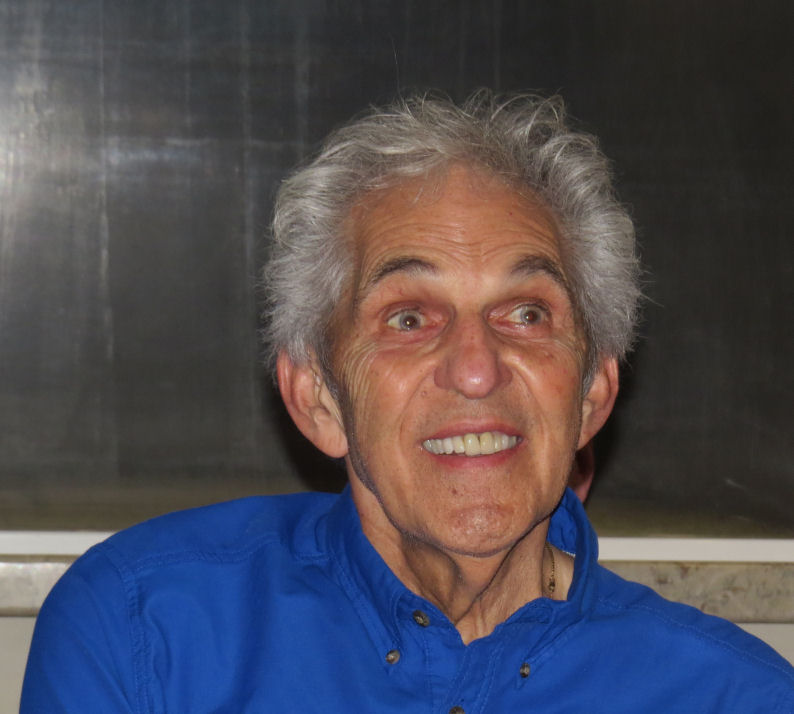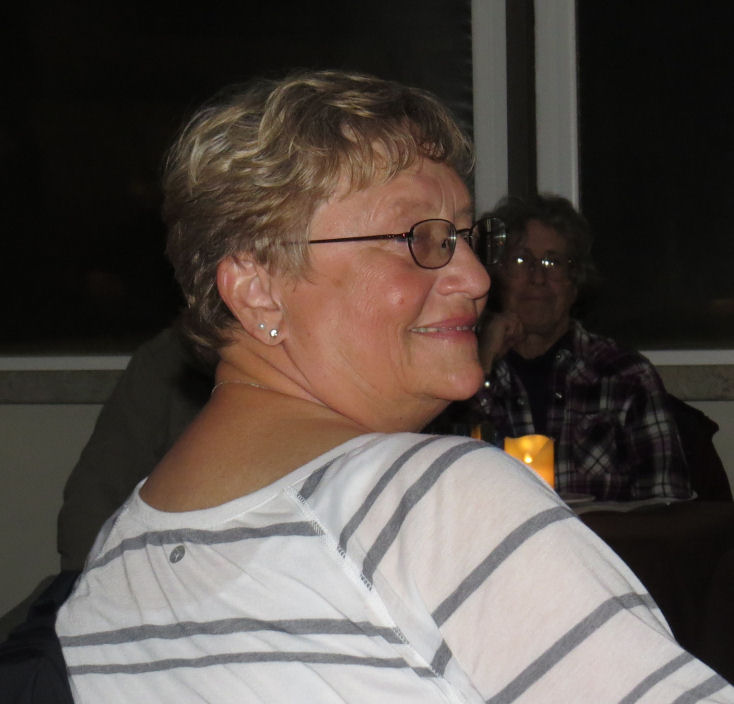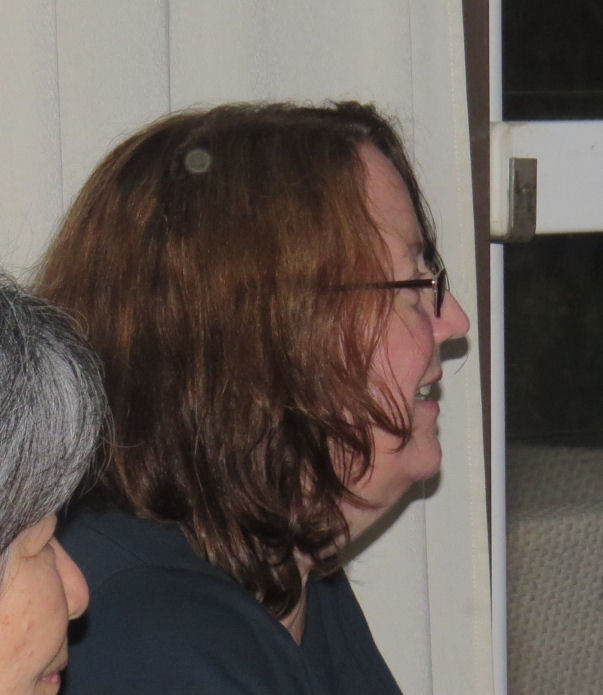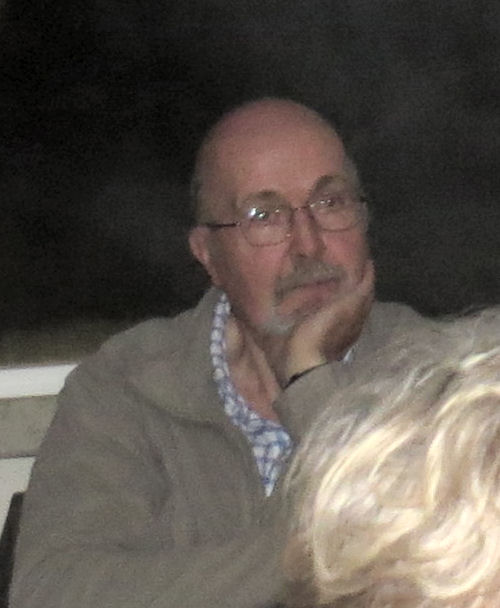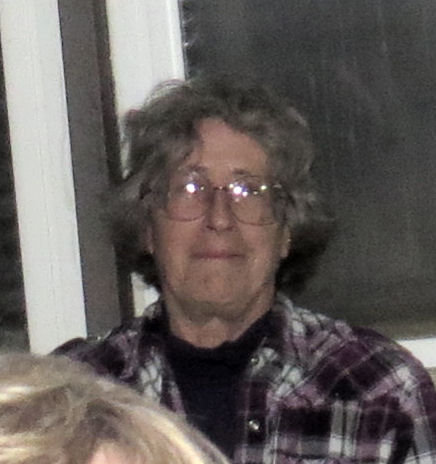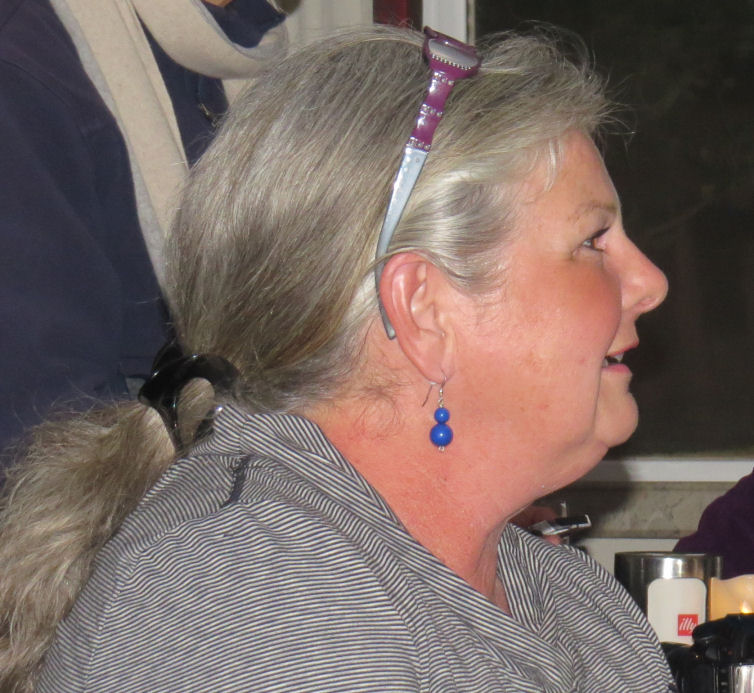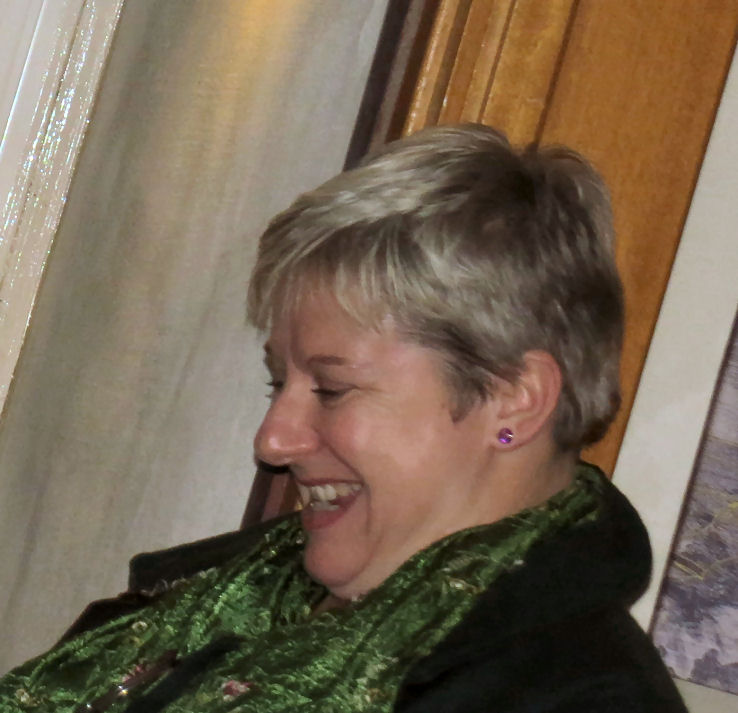
If we expected to hear more of that cracking sound that awakened us on the previous night, we were disappointed. I could imagine no possible explanation for this strange phenomenon.
Thanksgiving Day seemed to start pretty well. I slept quite soundly, and I felt better when I awoke. We had to get off to an early start because three stops were scheduled on our trip to the next night's lodging in Trapani (accent on the first syllable). Breakfast was the usual. The first day I did not realize that you could order cappuccino. The cup that they brought me on this second day was rather disappointing.
My tee shirts were not quite dry even after I had used the hair dryer on them. I had to stuff them into a separate compartment of my suitcase to avoid capillary action.
We were unable to connect Sue's laptop to the Internet.
If I did any reflecting that day, it was not upon what I had missed in Palermo. However, I have thought about it considerably in the interim. If I had it to do over again, I definitely would have planned more thoroughly about how to use the little free time that we had on Wednesday. Maybe I would have still been so tired that I would have wasted it napping in the hotel anyway. On the plus side, I had developed something of a feel for the streets of Palermo on Wednesday morning. On the other hand, I felt that I had missed some treasures in the historic center. Of course, others in the group had different values, but I put old-fashioned street markets in the same category as Nor'easters. If I never saw another one, I would be quite content.
The trip to the Archeological Museum had been draining. In retrospect the exhibit seemed like a hodgepodge to me. I definitely regretted that I probably would never again get a chance to see the final resting place of the incredible Frederick II and his two uninvited guests. Stupor Mundi has long been one of my very few heroes.

After breakfast we all turned in our room keys to the desk clerk and assembled outside of the hotel waiting for Susanna to clear everything with the hotel. It was not as warm as the previous day, and the breeze was noticeable. On the bus Susanna began by telling us about the original inhabitants of Sicily. There were three groups—the Elimi, the Sicani, and the Siculi (for whom the island is named).[1] The Elimi inhabited the western part of the island, the Sicani the center, and the Siculi the east. There may have been people that preceded these three groups, but little or nothing was known of them. The Sicilians have for millennia absorbed the cultures of stronger colonizers. Eventually, because of its position in the very center of the Mediterranean, Sicily became the center of Magna Grecia.
Susanna then changed the subject to current events in Italy. She said that the Mafia, which in Sicily was known simply as Cosa Nostra, “our thing,” was not restricted to Sicily. There were three other Mafia groups on the mainland in Naples (Camorra), Calabria (La 'ndrangheta), and Apulia (Sacra Corona Unita). The exploits of the first two were quite familiar to me, but I had never heard of the one in Apulia.
Susanna said that Sicily was in some ways more like a country than a region of Italy. Sicilian, for example, was considered a language, not a regional dialect. It had absorbed much more influence from invading cultures than the dialects had.
As the scenery became very hilly on the warm but windy day, we learned that since its unification as a republic during the Risorgimento, Italy had had three capitals. Because the Savoys, the ruling family, were from the Piedmont, the first capital was Turin. It was moved to Florence in 1865 and to Rome in in 1871 after the papal army was finally defeated.
The Prime Minister of Italy at the time of our tour of Sicily was Matteo Renzi, who was formerly mayor of Florence.[2] Italy also had a head of state who was called “president of the republic.” His duties were mostly ceremonial, but he also had a few important responsibilities. I have never quite been able to figure out how this exactly worked.
Over the last few decades the Cosa Nostra had diversified its operations. Its members were now heavily involved in real estate and managing garbage. There had been scandals concerning the burial of nuclear waste.
As we passed their memorial on the A29 near Capaci we learned about the contributions of Giovanni Falcone and Paolo Borsellino. Falcone had successfully prosecuted a large number of Mafia members during the “maxi processo” of the late eighties. In May of 1992 he, along with his wife and three police officers, was murdered by a dynamite blast on the A29. The judge in those trials, Borsellino, was murdered two months later in a bombing in a building in Palermo.
Susanna also told us about another anti-Mafia hero, Fr. Giuseppe Puglisi. At a time of strict omertà during which the very existence of the Mafia was denied even by the Archbishop of Palermo, Fr. Puglisi spoke out forcefully and repeatedly against organized crime in his Brancaccio neighborhood of Palermo. He was successful at dissuading young men from joining the organization. After Fr. Puglisi was murdered in 1993 in front of his parish church, his assassin turned himself into the police. He claimed that he had been suffering from horrible nightmares about Fr. Puglisi's killing.
Susanna described the movement called “Addiopizzo,” which roughly means “Good-bye Extortion.” Businesses in Sicily had long been subjected to paying protection money to the Cosa Nostra in order to stay in business.
We learned that the Mafia had developed in Sicily shortly after Italian unification in the second half of the nineteenth century. Susanna did not explain what caused it.[3]
Giuseppe at that point brought the bus to an unexpected stop on the side of the highway for a few minutes. Susanna later explained that he had missed the turn for Segesta. “It happens.”
Susanna explained that at our meals together table wines would always be provided. She also told us that on the last day of the tour we would be visiting the Benanti Winery. We would be treated to high-quality wines that day.
She then gave us a little more information about the ruined city of Segesta, which was one of the three major cities of the Elimi people. Segesta eventually became Hellenized. The ruins reflected the organization of a Greek city. The agora in a Greek city was the center of everyday life, but the temple was always in a separate place. Roman forums, in contrast, included the temple. The Greeks were more into intellectual and cultural undertakings. The Romans were more practical. They had Greek tutors, but their great innovations were concrete, arches, and passable roads.
The Moors and then the Normans came to Sicily after the Romans. A Roman amphitheater was actually two Greek theaters that faced one another. The Colosseum in Rome was an amphitheater.
The temple in Segesta was constructed as part of the Hellenization of the city. Previously Segesta had solicited help from Carthage in its longstanding dispute with Selinunte. According to Susanna the temple had never been completed because Siracusa defeated Athens, and there was no longer any reason to pretend that the temple was dedicated to Athena.
The town was destroyed several times over the centuries. It recovered from all of these disasters except the last one, which was perpetrated by the Vandals.
We all took a small bus up from the parking area, which was also the site of a “bar,”[4] to the site of the theater and the agora. It was extremely windy. I had to keep my hand on my hat the entire time. I took quite a few photos of the theater there, but I did not see much of great interest in the agora. I was the first to leave to walk back down to the parking area and from there to the temple. I wanted to have as much time there as possible.
I took a large number of photos of the temple and its Doric columns from every imaginable angle. My objective was to get photos that were devoid of both other tourists and the scaffolding. One of my friends from the Hartford Bridge Club is active in the Classical Association of New England. She was able to use some of my photos from our 2011 trip to Rome and the south of Italy in the association's annual project. I got a free set of posters and a box of note cards for my contribution.
After I returned to the site's headquarters, I purchased a cappuccino at the bar for €2. It was the worst that I have ever tasted. A woman with an absolutely incredible overbite sat at the next table while I tried to take photos of uncooperative birds.
Susanna told us that a “baglio” was a fortified farmhouse. I recorded no context for this remark, but our domicile in Agrigento would be a baglio that was converted into a hotel.
We also learned that our hostess for the buffet lunch that would serve as our Thanksgiving Day feast would be Maria Grammatico, an extremely famous pastry chef in Italy. Her specialties, as we would learn first-hand, were local pastries stuffed with ricotta.

Her pasticceria was near the medieval town of Erice (accent on the first syllable) that was situated high above Trapani, our ultimate destination for the day. It was originally inhabited by the Emili. The town that we would see was built on top of other civilizations. The bus would park at the Trapani Gate. “Trapanon” was reportedly the Greek word for sickle. Trapani received its name because of its shape.
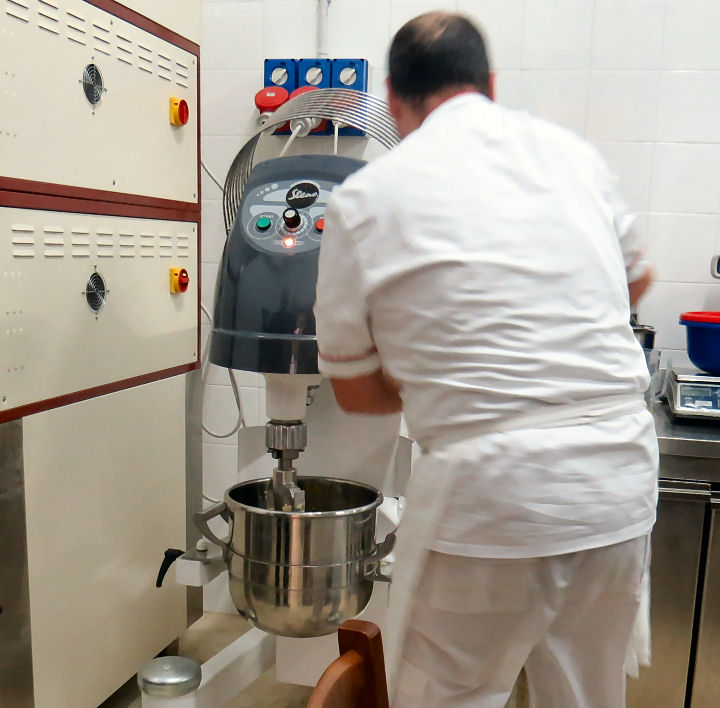
Susanna explained that the Romans discovered that mixing pozzulana and lime in a 2-1 ratio produced a very durable concrete. In the area of Erice they added broken clay of stones. The result was even more durable than Portland cement produced in the twenty-first century.
I saw a Chevrolet! At no point in the trip did I see a Honda automobile, but I did note a few Honda motorcycles. I did not see any Subarus either. There were plenty of Toyotas and a few Nissans both in Sicily and on the Italian peninsula.

I must have pressed a button on my camera that disabled the screen when it was in shooting mode. I tried pressing every button that I could find to reverse the effect. I looked at all the menu options. I tried removing the battery and reinserting it. Nothing worked. I did not bring the instruction book on the trip, and so, for the rest of the trip I had to rely on the viewfinder. This took away my ability to hold the camera over my head when shooting photos, something that would have been valuable during the pastry lesson.[5]
Signora Grammatico's pasticceria was really something. Although it appeared to be situated in the middle of nowhere, it was a really elegant and modern establishment. A smorgasbord of finger food is not what one usually associates with Thanksgiving dinner, but everything that Maria Grammatico touched was practically guaranteed to be delicious. Every item on the table confirmed this assessment. The individual items were much too diverse and numerous to bear listing.
She began by giving us the recipe for cannolis. The dough was made from flour, Marsala, margarine, vinegar, and vanilla. This produced a hard dough. In the old days she used a rolling pin to produce the flat thin product, and a broomstick was used to make the hole for the ricotta filling. Now a machine did all that. The edges of the squares were glued with a little egg and then the dough was deep-fried for six or seven minutes. She said that she used sunflower oil. The ricotta was 100 percent sheep's milk.
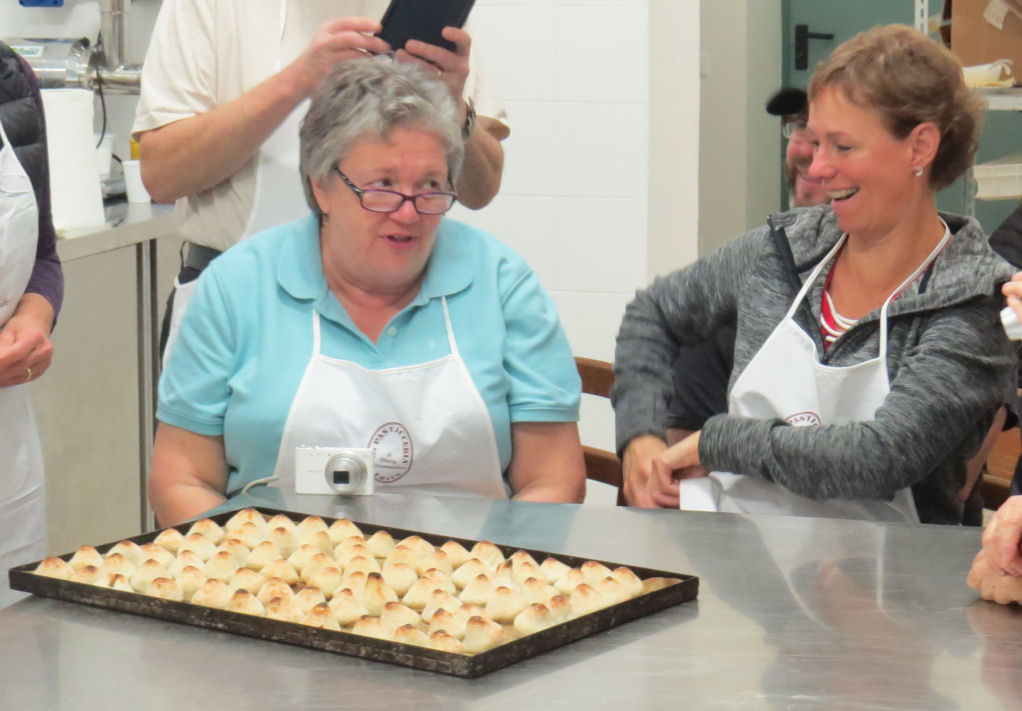
I have never been much of a fan of canollis. These, however, resembled nothing that I had ever tasted. They were very light and absolutely delicious.
After lunch we had a cooking demonstration in a much smaller room. Mrs. Grammatico made small balls of dough, which she handed to her assistant. The latter lady, who kept her left arm bent at a ninety-degree angle behind her, quickly rolled each ball of dough in a circle exactly five times. The result was somehow conical shaped. These concoctions were then baked at high temperatures for a few minutes. The results, which were known as “nun's teats” were astoundingly delicious for such a simple item.
Some members of the group tried to emulate the rolling technique with results ranging from wildly comical to passable. No one, however, came close to qualifying to replace Mrs. Grammatico's assistant.
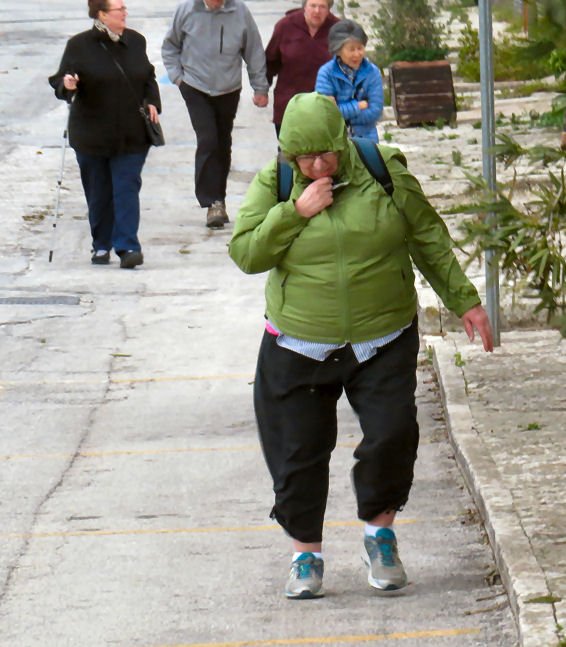
At some point during the day my tour buddy, Ann Oglesby, and I interviewed one another. I learned that she was a civilian employee of the federal government who handled logistics. Originally from Texas, she had worked for many years for the Department of Defense, but now she was assigned to the Department of State in Frankfurt. She said that she really liked her new assignment. She had done a great deal of traveling both for work and for pleasure. She gave me the totally unnecessary advice that I should avoid going to Djibouti.
I told her about our software company, my heroic service in the army, my work for the New England Bridge Conference, and our trip to Tanzania last year. I also told her about my fascination with the popes.
Giuseppe drove us up[6] to Erice. The wind up there was fierce. Overhanging clouds were doing their best to ruin the views. Susanna warned us that she thought that we might be touring a ghost town, but she said that the Castle of Venus was very interesting and well worth the walk. A large group of us took her up on it. Sue made it about two-thirds of the way up and then settled on a bench.
Well, it might have been worth the walk under normal conditions, but the castle was closed. Despite the poor visibility I took a few photos. I then headed back down to to collect Sue. We decided to walk back on a different street that was much more sheltered from the wind. We came upon a shop that was open. Sue stepped in there for quite a few minutes. I sat outside on the stoop in front of someone's house trying to fix my camera.
We only saw a few people in Erice who were not members of our group. It was not “a fit night out for man nor beast.”[7] I only exaggerated a little when I reported back to Susanna “Abbiamo visto due persone e tre spettri.” We saw two people and three ghosts.
The original plan was to take the cable car from Erice down to Trapani, but the winds eliminated that possibility. I don't think that it was operating at that time of year anyway.
Giuseppe drove us down to Trapani, where we checked into the Residence La Gancia, which was on the long peninsula that enclosed Trapani's port. A lady from the hotel had to show us to our room, 302. It was located on the other side of some stairs that led outside.
A few minutes later Susanna took us on a short orientation walk. Sue decided not to come with us. Basically we walked down Via Garibaldi to the Mucicipio, the City Hall with a tall clock[8] tower. There we turned right onto a street that boasted many very modern stores. Some even featured “Black Friday” sales, which must have been totally incomprehensible to the natives. I doubt that even half of Americans understand where the concept of a Black Friday sale originated.
We passed the “College” of the Jesuits, which appeared to be closed. We stepped into the nearby Church of the Purgatory, which had a large number of what Susanna called “floats” that were used in a parade. She said that each was associated with one of the stations of the cross. Each was maintained by one of the guilds in the town. I found these pretty interesting, and I knew that they would be very appealing to Sue.
I did not notice any eateries that looked particularly promising, but the orientation walk was rather short. We almost exclusively stayed on just one street.
At 7:00 the group met in the little room on the rooftop of the hotel. We were protected from the weather, but it was very cramped. Sue and I sat with Laurie, an act that caused Leslie to need to move. This was not what we intended, but it happened. I had to sit sidesaddle because there was no room for my legs under the table. Prosecco was served, along with a pretty good assortment of munchies. The potato chips were the worst that I had ever tasted, but I compensated by devouring a mountain of shelled and salted peanuts.
Each of us had been assigned the task of interviewing our buddies so that we could introduce them to the group. I have always taken this responsibility very seriously, but I had often been disappointed with the efforts of others. The speeches of introduction this time were pretty good. Only a few people had not bothered to learn anything about their buddies. Here is what I gleaned about our cast of characters from the speeches and from later encounters.
Sallie Baldwin was a history major, but she claimed that she did not remember anything. She claimed to be one of the oldest social workers in the world. Evidently she took care of her sister at their home in Longmeadow, but she also did a lot of work for some kind of agency. She said that she was older than many of her clients. Ann told me that she was a good roommate.
Laurie Coles was from Dallas. I did not learn much about her except that she knew how to do the Pony and also knew the words to the first verse of Manfred Mann's[9] 1964 hit “Do Wah Diddy Diddy.”[10]
Leslie Baughman was traveling with Laurie. Susanna was supposed to introduce her, but she evidently never interviewed her. I later learned from Sue that Leslie was a dean at a college. She also told us that she was part Greek.
Rollin Flower was a retired IT guy from Kinderhook, NY. Sue and I got to eat dinner with the Flowers a few nights later, and he told me about the places in which he had worked. If you wanted to find the fastest way back to the hotel from anywhere, he was the guy to follow.
Rollin's wife Joyce was into basket-weaving. She taught others how to make baskets and exhibited and sold her work. I learned this from sitting behind her on the bus a few times.
Wendall Heinrichs and his wife Carol were honest-to-goodness farmers from near Winnipeg. The trip was a surprise fiftieth-birthday present for Carol from their children. She only had thirty-six hours to get ready for the trip. I had met plenty of farmers before, but never on Rick Steves tours.
Emily Kao was from the Boston area. I did not learn much about her, but she always seemed to be the most interested in learning what the local guides had to say. She also served as the tour's meteorologist. Her forecasts were spot on.
Her brother P.C. was Sue's buddy. Emily had proposed that P.C. and his wife join her on the tour. They were both interested, but his wife was turned off by the “no grumps” policy listed in Rick Steves promotional material. Like many of the people in this group, P.C. was a techie. Although his specialty was electronic communications, he was embarrassed to report that he had been unable to get someone else's “send” function in e-mail to work. P.C. had taught both in the U.S. And China.
Sue told me that K.B. Low and Swee Mee Phang had both worked at IBM. They now maintained homes in Malaysia and Toronto.
Bob and Barb Metranga were from the Sacramento area. I did not learn a great deal about them either. Evidently Barb was a bocci player, and Bob, who was of Sicilian descent, could not drink red wine without getting a headache. In Sicily that would be as bad as having gluten intolerance in the Czech Republic.
Tom and Rose Mary Meyer spent their summers in Minneapolis and their winters in Tucson. Tom was an avid cyclist, and, I think, Rose Mary was only slightly less so. I wish that we had gotten a chance to know them a little better.
Barbara Pissaro had spent several days with distant Sicilian relatives before the tour began. She spoke Italian pretty well. I learned her husband Nick's amazing story when we ate with them the next day. Among other things he designed a clone for the IBM 370 back in the day. Over the years he was a principle in several high-tech companies and sold at least one of them. He still designed apps for Apple products and did some consulting work. He was also heavily into photography.
Diane Snyder was from San Antonio. I think that I overheard her say that she was a Longhorn.
Bob and Martha Turner were from Marietta, GA. Emily said that they moved there in order to be near their children. If I heard correctly, Bob was involved in pharmaco-kinetics. Martha made quilts.
Karen Williams and Jon Morosini had only been together for a few years, but they had known each other since third grade. They even rode on the same school bus. According to Karen, she was a geek, and he was a jock. “Geek” meant something entirely different in those days. I was not even sure if the term “nerd” was yet in use, but I could not picture Karen as either one. Karen worked as a nurse; Jon worked on submarines at Electric Boat. Karen had had a lot of other more adventurous jobs before settling on nursing, including testing products for J.C. Penney. They lived in Groton, CT.
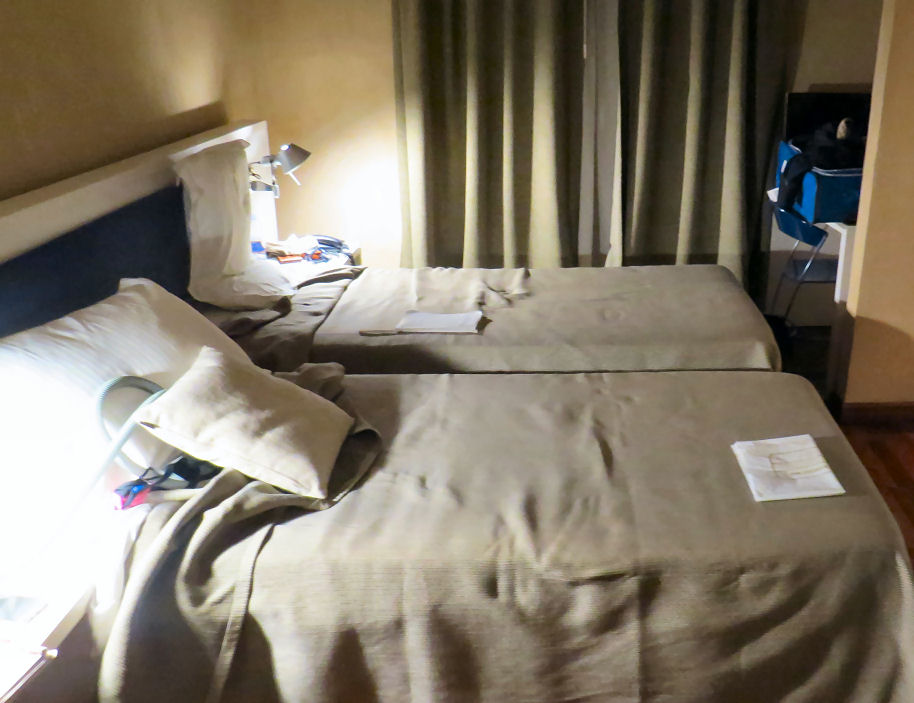
The shower was very nice. You could use the overhead shower head or the one that you held in your hand.
The Internet connection in the room seemed to be quite good.
By the end of the day I felt a little punk. I was still coughing a bit—especially when I ate something. I took a couple of acetaminophen tablets for my slight fever.
It rained and thundered almost all night. To me it sounded like Ragnarok, but Sue slept so soundly that she never even noticed it.
[1] These are the Italian names. In English the groups are usually called the Emylians, the Sicanians, and the Sicels.
[2] Renzi resigned shortly after the end of the tour.
[3] That task was left up to our local guide in Scicli, Roberto.
[4] In Italy a “bar” refers to any establishment that sells food and/or beverages from a counter. Usually one pays the cashier and then brings a receipt to the person dispensing the items.
[5] My brain must not have been functioning. I fixed this problem in thirty seconds when I got back home.
[6] Erice is only ten kilometers from Trapani, but it is 751 meters above sea level.
[7] This line is from W.C. Field's famous short, “The Fatal Glass of Beer.”
[8] The time was way off. I saw plenty of clocks in public squares in Sicily. Not one had anything close to the correct time. Maybe a few high schools should teach clock repair.

